Exploring the Tidyverse, a modern R "dialect"
Last updated on 2025-04-15 | Edit this page
Overview
Questions
- What are the most common types of operations someone might perform on a data frame in R?
- How can you perform these operations clearly and efficiently?
Objectives
- Subset a data set to a smaller, targeted set of rows and/or columns.
- Sort or rename columns.
- Make new columns using old columns as inputs.
- Generate summaries of a data set.
- Use pipes to string multiple operations on the same data set together into a “paragraph.”
Preparation and setup
Note: These lessons uses the gapminder data set. This data set can be accessed using the following commands:
R
install.packages("gapminder") #ONLY RUN THIS COMMAND IF YOU HAVE NOT ALREADY INSTALLED THIS PACKAGE.
OUTPUT
The following package(s) will be installed:
- gapminder [1.0.0]
These packages will be installed into "~/work/r-novice-gapminder/r-novice-gapminder/renv/profiles/lesson-requirements/renv/library/linux-ubuntu-jammy/R-4.4/x86_64-pc-linux-gnu".
# Installing packages --------------------------------------------------------
- Installing gapminder ... OK [linked from cache]
Successfully installed 1 package in 5.1 milliseconds.R
library(gapminder) #TURN THE PACKAGE ON
gap = as.data.frame(gapminder) #CREATE A VERSION OF THE DATA SET NAMED gap FOR CONVENIENCE
These lessons revolve around the packages in the so-called
“tidyverse”—a suite array of R packages containing extremely
useful tools that are all designed to look similar and work well
together. Many of these tools allow you to do operations more
efficiently, clearly, or quickly than you can in “base R.” As such, most
things we’ll do in these lessons can be done in “base R” too, but it
won’t (typically) be as efficient, clear, or fast! As such, the
tidyverse packages can be viewed as a modern “dialect” of R
that many (though not all!) R users use in place of (or in concert with)
base R in their day-to-day workflows.
dplyr, ggplot2, and tidyr, the
specific packages we’ll use in these lessons, are like many add-on
packages for R in that they do not come pre-installed
with R. We can install them using this command:
R
install.packages(c("dplyr", "ggplot2", "tidyr")) #ONLY RUN THIS COMMAND IF YOU HAVEN'T ALREADY INSTALLED THESE PACKAGES.
You only need to install a package once (just like you only need to
install a program once), so there’s no need to run the above command
more than once. [However, packages are updated occasionally. When
updates are available, you can re-install new versions using the same
install.packages() function.]
When you launch R or RStudio, none of the add-on packages you have
installed with be “turned on” by default. either So, to turn on
dplyr so that we can access its features, we use a
library() call:
R
library(dplyr) #RUN EACH TIME YOU START UP R AND WANT TO USE THIS PACKAGE'S FEATURES.
library(ggplot2)
library(tidyr)
The above command must be run every time you start up R and want to access these packages’ features.
Data Frame Manipulation with dplyr
R is designed for working with data and data sets. Because data
frames (and tibbles, their tidyverse equivalents) are the
primary object types for holding data sets in R, R users work with data
frames (and tibbles) A LOT…like, a lot a lot.
When working with data sets stores as data frames (or tibbles), we very often find ourselves needing to perform certain actions, such as cutting certain rows or columns out of these objects, renaming columns, or transforming columns into new ones.
We can do ALL of those things in “base R” if we wanted to. In fact,
our
“Welcome to R!” lessons demonstrated how to do some of these actions
in base R. However, dplyr makes doing all these things
easier, more concise, AND more intuitive. It does this by adding new
verbs (functions) to the R language that all use a consistent syntax and
structure (and have intuitive names), allowing us to write code in
connected “paragraphs” that do more than commands usually can while
also, somehow, being easier to read.
In this lesson, we’ll go through the most common dplyr
verbs, showing off their uses.
SELECT and RENAME
What if we wanted to create a subset of our current data set (a
version lacking some rows and/or columns)? When it comes to subsetting
by columns, the dplyr verb corresponding to this desire is
select().
Callout
Important: I said above that one of the strengths of
dplyr is that all its verbs share a similar structure.
Every major dplyr verb, including select(),
takes as its first input the data frame (or tibble) you’re trying to
manipulate.
After that first input, every subsequent input you provide becomes another “thing” you want the function to do to that data frame.
What I mean by that last part will become clearer via an example.
Suppose I want a new, smaller version of the gapminder data
set that is only the country and year
columns from the original. I could use select() to achieve
that desire like this:
R
gap_shrunk = select(gap, #1ST INPUT IS ALWAYS THE DATA FRAME TO BE MANIPULATED
country, year) #EACH SUBSEQUENT INPUT IS "ANOTHER THING TO DO" TO THAT DATA FRAME. HERE, IT'S THE COLUMNS WE WANT TO KEEP IN OUR SUBSET.
head(gap_shrunk)
OUTPUT
country year
1 Afghanistan 1952
2 Afghanistan 1957
3 Afghanistan 1962
4 Afghanistan 1967
5 Afghanistan 1972
6 Afghanistan 1977In the example above, I provided my data frame as the first input to
select() and then all the columns I wanted to
select as subsequent inputs. As a result, I ended up with a
shrunken version of the original data set, one containing only those two
columns.
Callout
Notice that, in the tidyverse packages, column names are
often unquoted when used as inputs.
In
our subsetting and indexing lesson, we learned some “tricks” for
subsetting objects in R. Many of those tricks with select()
too. For example, you can select a sequence of consecutive columns by
using the : operator and the names of the first and last
columns in that sequence:
R
gap_sequence = select(gap,
pop:lifeExp) #SELECT ALL COLUMNS FROM pop TO lifeExp
head(gap_sequence)
OUTPUT
pop lifeExp
1 8425333 28.801
2 9240934 30.332
3 10267083 31.997
4 11537966 34.020
5 13079460 36.088
6 14880372 38.438We can also use the - operator to specify columns we
want to reject instead of keep. For example, to retain every
column except year, we could do this:
R
gap_noyear = select(gap,
-year) #EXCLUDE YEAR FROM THE SUBSET
head(gap_noyear)
OUTPUT
country continent lifeExp pop gdpPercap
1 Afghanistan Asia 28.801 8425333 779.4453
2 Afghanistan Asia 30.332 9240934 820.8530
3 Afghanistan Asia 31.997 10267083 853.1007
4 Afghanistan Asia 34.020 11537966 836.1971
5 Afghanistan Asia 36.088 13079460 739.9811
6 Afghanistan Asia 38.438 14880372 786.1134We can also use select() to rearrange columns
by specifying the column names in the new order we want them in:
R
gap_reordered = select(gap,
year, country) #THE ORDER HERE SPECIFIES THE ORDER IN THE SUBSET
head(gap_reordered)
OUTPUT
year country
1 1952 Afghanistan
2 1957 Afghanistan
3 1962 Afghanistan
4 1967 Afghanistan
5 1972 Afghanistan
6 1977 AfghanistanRenaming
What if wanted to rename some of our columns? The dplyr
verb corresponding to this desire is, fittingly,
rename().
As with select() (and all dplyr
verbs!), rename()’s first input is the data frame we’re
manipulating. Each subsequent input is an “instructions list” for how to
do that renaming, with the new name to give to a column to the left of
an = operator and the old name of that column to the right
of it (what I like to call new = old format).
For example, to rename the pop column to “population,”
which I would personally find to be more informative, we would
do the following:
R
gap_renamed = rename(gap,
population = pop) #NEW = OLD FORMAT TO RENAME COLUMNS
head(gap_renamed)
OUTPUT
country continent year lifeExp population gdpPercap
1 Afghanistan Asia 1952 28.801 8425333 779.4453
2 Afghanistan Asia 1957 30.332 9240934 820.8530
3 Afghanistan Asia 1962 31.997 10267083 853.1007
4 Afghanistan Asia 1967 34.020 11537966 836.1971
5 Afghanistan Asia 1972 36.088 13079460 739.9811
6 Afghanistan Asia 1977 38.438 14880372 786.1134It’s as simple as that! If we wanted to rename multiple columns at
once, we could add more inputs to the same rename()
call.
Magical pipes
Challenge
What if I wanted to first eliminate some columns and then rename some of the remaining columns? How would you accomplish that goal, based on what I’ve taught you so far?
Your first impulse might be to do this in two commands, saving intermediate objects at each step, like so:
R
gap_selected = select(gap,
country:pop) #FIRST, CREATE OUR SUBSET, AND SAVE AN INTERMEDIATE OBJECT CALLED gap_selected.
gap_remonikered = rename(gap_selected,
population = pop) #USE THAT OBJECT IN THE RENAMING COMMAND.
head(gap_remonikered)
OUTPUT
country continent year lifeExp population
1 Afghanistan Asia 1952 28.801 8425333
2 Afghanistan Asia 1957 30.332 9240934
3 Afghanistan Asia 1962 31.997 10267083
4 Afghanistan Asia 1967 34.020 11537966
5 Afghanistan Asia 1972 36.088 13079460
6 Afghanistan Asia 1977 38.438 14880372There’s nothing wrong with this approach, but it’s…tedious. Plus, if you don’t pick really good names for each intermediate object, it can get confusing for you and others to read.
I hope you’re thinking “I bet there’s a better way.” And there is! We can combine these two discrete “sentences” into one, easy-to-read “paragraph.” The only catch is we have to use a strange operator called a pipe to do it.
dplyr pipes look like this: %>%. On
Windows, the hotkey to render a pipe is Control + shift + m! On Mac,
it’s similar: Command + shift + m.
Callout
Pipes may look a little funny, but they do something really cool. They take the “thing” produced on their left (once all operations over there are complete) and “pump” that thing into the operations on their right automatically, specifically into the first available input slot.
This is easier to explain with an example, so let’s see how to use pipes to perform the two operations we did above in a single command:
R
gap.final = gap %>% #START WITH OUR RAW DATA SET, THEN PIPE IT INTO...
select(country:pop) %>% #OUR SELECT CALL, THEN PIPE THE RESULT INTO...
rename(population = pop) #OUR RENAME CALL. PIPES ALWAYS PLACE THEIR "BURDENS" IN THE FIRST AVAILABLE INPUT SLOT, WHICH IS WHERE dplyr VERBS EXPECT THE DATA FRAME TO GO ANYWAY!
head(gap.final)
OUTPUT
country continent year lifeExp population
1 Afghanistan Asia 1952 28.801 8425333
2 Afghanistan Asia 1957 30.332 9240934
3 Afghanistan Asia 1962 31.997 10267083
4 Afghanistan Asia 1967 34.020 11537966
5 Afghanistan Asia 1972 36.088 13079460
6 Afghanistan Asia 1977 38.438 14880372The command above says: “Take the raw gapminder data set
and pump it into select()’s first input slot (where it
belongs anyway). Then, do select()’s operations (which
yield a new, subsetted data set) and pump that into
rename()’s first input slot. Then, when that function is
done, save the result into an object called gap.final.”
Hopefully, you can see how “dplyr paragraphs” like this
one could be easier to read and follow along with but more
code-efficient too! The existence of pipes also explains why every
dplyr verb’s first input slot is the data frame to be
manipulated—it makes every verb ready to receive “upstream” inputs via a
pipe!
Pipes are so useful to writing clean, efficient
tidyverse code that few tidyverse users eschew
them. So, we’ll be using them for the rest of this lesson and the ones
beyond, so you’ll get plenty of practice with them!
FILTER, ARRANGE, and MUTATE
What if we only wanted to look at data from a specific continent or a
specific time frame (i.e., we wanted to subset by rows
instead)? The dplyr verb corresponding to this desire is
filter() (see, I said dplyr verbs have
intuitive names!).
Each input given to filter() past the first (which is
ALWAYS the data frame to be manipulated, as we’ve established!) is a
logical test, a construction we’ve seen before.
Each logical testhere willconsist of the name of the
column we’ll check the values of, a logical operator
(like == for “is equal to” or <= for “is
less than or equal to”), and a “threshold” to check the values in that
column against.
If all the logical tests pass for a particular row, we keep that row. Otherwise, we remove that row from the new, subsetted data frame we create.
For example, here’s how we’d filter our data set to just rows where
the value in the continent column is exactly
"Europe":
R
gap_europe = gap %>%
filter(continent == "Europe") #THE COLUMN TO CHECK VALUES IN, AN OPERATOR, THEN THE THRESHOLD VALUE TO CHECK THEM AGAINST.
head(gap_europe)
OUTPUT
country continent year lifeExp pop gdpPercap
1 Albania Europe 1952 55.23 1282697 1601.056
2 Albania Europe 1957 59.28 1476505 1942.284
3 Albania Europe 1962 64.82 1728137 2312.889
4 Albania Europe 1967 66.22 1984060 2760.197
5 Albania Europe 1972 67.69 2263554 3313.422
6 Albania Europe 1977 68.93 2509048 3533.004As another example, here’s how we’d filter our data set to just rows
with data from before the year 1975:
R
gap_pre1975 = gap %>%
filter(year < 1975)
head(gap_pre1975)
OUTPUT
country continent year lifeExp pop gdpPercap
1 Afghanistan Asia 1952 28.801 8425333 779.4453
2 Afghanistan Asia 1957 30.332 9240934 820.8530
3 Afghanistan Asia 1962 31.997 10267083 853.1007
4 Afghanistan Asia 1967 34.020 11537966 836.1971
5 Afghanistan Asia 1972 36.088 13079460 739.9811
6 Albania Europe 1952 55.230 1282697 1601.0561Challenge
What if we wanted data only from between the years 1970 and
1979? How would you achieve this goal using filter()? Hint:
There are at least three valid ways you should be able to think
of to do this!
The first solution is to use & (R’s “AND” operator)
to specify two rules a value in the year column must
satisfy to pass:
R
and_option = gap %>%
filter(year > 1969 &
year < 1980) #YOU COULD USE LESS THAN OR EQUAL TO OPERATORS HERE ALSO, BUT DIFFERENT YEAR VALUES WOULD BE NEEDED.
However, I said earlier that every input to filter()
past the first is another logical test a row
must satisfy to pass. So, just specifying two logical
testshere, with a comma in between, has the same effect:
R
comma_option = gap %>%
filter(year > 1969,
year < 1980)
Of course, if you prefer, you can use multiple filter()
calls back to back, each containing just one rule:
R
stacked_option = gap %>%
filter(year > 1969) %>%
filter(year < 1980)
None of these approaches is “right” or “wrong,” so you can decide which ones you prefer!
Challenge
Important: When chaining dplyr verbs
together in “paragraphs” via pipes, order matters! Why
does the following code trigger an error when
executed?
R
this_will_fail = gap %>%
select(pop:lifeExp) %>%
filter(year < 1975)
Recall that the year column is not one of the
columns between the pop and lifeExp columns.
So, the year column gets cuts by the select()
call here before we get to the filter() call that
tries to use it as an input, so the filter() call fails to
find that column.
Considering that dplyr “paragraphs” can get long and
complicated, remember to be thoughtful about the order you specify
actions in!
Sorting
What if we wanted to sort our data set by the values in one
(or more) columns? The dplyr verb corresponding to this
desire is arrange().
Every input past the first given to arrange() is a
column we want to sort by, with earlier columns taking “precedence” over
later ones.
For example, here’s how we’d sort our data set by the
lifeExp column (in ascending order):
R
gap_sorted = gap %>%
arrange(lifeExp)
head(gap_sorted)
OUTPUT
country continent year lifeExp pop gdpPercap
1 Rwanda Africa 1992 23.599 7290203 737.0686
2 Afghanistan Asia 1952 28.801 8425333 779.4453
3 Gambia Africa 1952 30.000 284320 485.2307
4 Angola Africa 1952 30.015 4232095 3520.6103
5 Sierra Leone Africa 1952 30.331 2143249 879.7877
6 Afghanistan Asia 1957 30.332 9240934 820.8530Ascending order is the default for arrange(). If we want
to reverse it, we use the desc() helper function:
R
gap_sorted_down = gap %>%
arrange(desc(lifeExp)) #DESCENDING ORDER INSTEAD.
head(gap_sorted_down)
OUTPUT
country continent year lifeExp pop gdpPercap
1 Japan Asia 2007 82.603 127467972 31656.07
2 Hong Kong, China Asia 2007 82.208 6980412 39724.98
3 Japan Asia 2002 82.000 127065841 28604.59
4 Iceland Europe 2007 81.757 301931 36180.79
5 Switzerland Europe 2007 81.701 7554661 37506.42
6 Hong Kong, China Asia 2002 81.495 6762476 30209.02Challenge
I mentioned above that you can provide multiple inputs to
arrange(), but it’s a little hard to explain what
this does, so let’s try it and see what happens:
R
gap_2xsorted = gap %>%
arrange(year, continent)
head(gap_2xsorted)
OUTPUT
country continent year lifeExp pop gdpPercap
1 Algeria Africa 1952 43.077 9279525 2449.0082
2 Angola Africa 1952 30.015 4232095 3520.6103
3 Benin Africa 1952 38.223 1738315 1062.7522
4 Botswana Africa 1952 47.622 442308 851.2411
5 Burkina Faso Africa 1952 31.975 4469979 543.2552
6 Burundi Africa 1952 39.031 2445618 339.2965What did this command do? Why? What would change if you reversed the
order of continent and year in the call?
This command first sorted the data set by the unique values
in the year column. It then “broke any ties,” in which 2+
rows have the same year value, by then
sorting by the continent column’s values within each of
those tied groups.
So, we get records for Africa sooner than we get records
for Asia for the same year, but records from
Africa and Asia alternate as we go through all
the years. If we reversed the order of our two inputs, we’d instead get
all records for Africa, in chronological order by
year, before getting any records for
Asia.
This mirrors the behavior of “multi-column sorting” as it exists in programs like Microsoft Excel.
Generating new columns
What if we wanted to make a new column using an old column’s values
as inputs? This is the kind of thing many of us are used to doing in
Microsoft Excel, where it isn’t always easy or reproducible. Thankfully,
we have the dplyr verb mutate() to match with
this desire.
Every input to mutate() past the first is an
“instructions list” for how to make a new column using one or more old
columns as inputs, and these follow new = old format
again.
For example, here’s how we would create a new column called
pop1K that is made by dividing the pop
column’s values by 1000:
R
gap_newcol = gap %>%
mutate(pop1K = round(pop / 1000)) #NEW = OLD FORMAT. WHAT WILL THE NEW COLUMN BE CALLED, AND HOW SHOULD WE OPERATE ON THE OLD COLUMN TO MAKE IT?
head(gap_newcol)
OUTPUT
country continent year lifeExp pop gdpPercap pop1K
1 Afghanistan Asia 1952 28.801 8425333 779.4453 8425
2 Afghanistan Asia 1957 30.332 9240934 820.8530 9241
3 Afghanistan Asia 1962 31.997 10267083 853.1007 10267
4 Afghanistan Asia 1967 34.020 11537966 836.1971 11538
5 Afghanistan Asia 1972 36.088 13079460 739.9811 13079
6 Afghanistan Asia 1977 38.438 14880372 786.1134 14880You’ll note that the old pop column still exists after
this command. If you want to get rid of it, now that you’ve used it, you
can specify the input .keep = "unused" to
mutate() and it will eliminate any columns used to create
new ones. Try it!
GROUP_BY and SUMMARIZE
One the most powerful actions we might want to take on a data set is to generate a summary. “What’s the mean of this column?” or “What’s the median value for all the different groups in that column?”, for example.
Suppose we wanted to calculate the mean life expectancy across all
years for each country. We could use filter() to
go country by country, save each subset as an intermediate
object, and then take a mean of each subset’s
lifeExp column. It’d work, but what a pain it’d
be!
Thankfully, we don’t have to; instead, we can use the
dplyr verbs group_by() and
summarize()! Unlike other dplyr verbs we’ve
met so far, these are a duo—they’re generally used together
and, importantly, we always use group_by() first
when we do use them as a pair.
So, let’s start by understanding what group_by() does.
Each input given to group_by() past the first creates
groupings in the data. Specifically, you provide a column name, and R
will find all the different values in that column (such as all the
different unique country names) and subtly “bundle up” all the rows that
possess each different value.
…This is easier to show you than to explain, so let’s try it:
R
gap_grouped = gap %>%
group_by(country) #FIND EACH UNIQUE COUNTRY AND BUNDLE ROWS FROM THE SAME COUNTRY TOGETHER.
head(gap_grouped)
OUTPUT
# A tibble: 6 × 6
# Groups: country [1]
country continent year lifeExp pop gdpPercap
<fct> <fct> <int> <dbl> <int> <dbl>
1 Afghanistan Asia 1952 28.8 8425333 779.
2 Afghanistan Asia 1957 30.3 9240934 821.
3 Afghanistan Asia 1962 32.0 10267083 853.
4 Afghanistan Asia 1967 34.0 11537966 836.
5 Afghanistan Asia 1972 36.1 13079460 740.
6 Afghanistan Asia 1977 38.4 14880372 786.When we look at the new data set, it will look as though
nothing has changed. And, in a lot of ways, nothing has! However, if you
examine gap_grouped in your RStudio’s ‘Environment’ Pane,
you’ll notice that gap_grouped is considered a “grouped
data frame” instead of a plain-old one.
We can see what that means by using the str()
(“structure”) function to peek “under the hood” at
gap_grouped:
R
str(gap_grouped)
OUTPUT
gropd_df [1,704 × 6] (S3: grouped_df/tbl_df/tbl/data.frame)
$ country : Factor w/ 142 levels "Afghanistan",..: 1 1 1 1 1 1 1 1 1 1 ...
$ continent: Factor w/ 5 levels "Africa","Americas",..: 3 3 3 3 3 3 3 3 3 3 ...
$ year : int [1:1704] 1952 1957 1962 1967 1972 1977 1982 1987 1992 1997 ...
$ lifeExp : num [1:1704] 28.8 30.3 32 34 36.1 ...
$ pop : int [1:1704] 8425333 9240934 10267083 11537966 13079460 14880372 12881816 13867957 16317921 22227415 ...
$ gdpPercap: num [1:1704] 779 821 853 836 740 ...
- attr(*, "groups")= tibble [142 × 2] (S3: tbl_df/tbl/data.frame)
..$ country: Factor w/ 142 levels "Afghanistan",..: 1 2 3 4 5 6 7 8 9 10 ...
..$ .rows : list<int> [1:142]
.. ..$ : int [1:12] 1 2 3 4 5 6 7 8 9 10 ...
.. ..$ : int [1:12] 13 14 15 16 17 18 19 20 21 22 ...
.. ..$ : int [1:12] 25 26 27 28 29 30 31 32 33 34 ...
.. ..$ : int [1:12] 37 38 39 40 41 42 43 44 45 46 ...
.. ..$ : int [1:12] 49 50 51 52 53 54 55 56 57 58 ...
.. ..$ : int [1:12] 61 62 63 64 65 66 67 68 69 70 ...
.. ..$ : int [1:12] 73 74 75 76 77 78 79 80 81 82 ...
.. ..$ : int [1:12] 85 86 87 88 89 90 91 92 93 94 ...
.. ..$ : int [1:12] 97 98 99 100 101 102 103 104 105 106 ...
.. ..$ : int [1:12] 109 110 111 112 113 114 115 116 117 118 ...
.. ..$ : int [1:12] 121 122 123 124 125 126 127 128 129 130 ...
.. ..$ : int [1:12] 133 134 135 136 137 138 139 140 141 142 ...
.. ..$ : int [1:12] 145 146 147 148 149 150 151 152 153 154 ...
.. ..$ : int [1:12] 157 158 159 160 161 162 163 164 165 166 ...
.. ..$ : int [1:12] 169 170 171 172 173 174 175 176 177 178 ...
.. ..$ : int [1:12] 181 182 183 184 185 186 187 188 189 190 ...
.. ..$ : int [1:12] 193 194 195 196 197 198 199 200 201 202 ...
.. ..$ : int [1:12] 205 206 207 208 209 210 211 212 213 214 ...
.. ..$ : int [1:12] 217 218 219 220 221 222 223 224 225 226 ...
.. ..$ : int [1:12] 229 230 231 232 233 234 235 236 237 238 ...
.. ..$ : int [1:12] 241 242 243 244 245 246 247 248 249 250 ...
.. ..$ : int [1:12] 253 254 255 256 257 258 259 260 261 262 ...
.. ..$ : int [1:12] 265 266 267 268 269 270 271 272 273 274 ...
.. ..$ : int [1:12] 277 278 279 280 281 282 283 284 285 286 ...
.. ..$ : int [1:12] 289 290 291 292 293 294 295 296 297 298 ...
.. ..$ : int [1:12] 301 302 303 304 305 306 307 308 309 310 ...
.. ..$ : int [1:12] 313 314 315 316 317 318 319 320 321 322 ...
.. ..$ : int [1:12] 325 326 327 328 329 330 331 332 333 334 ...
.. ..$ : int [1:12] 337 338 339 340 341 342 343 344 345 346 ...
.. ..$ : int [1:12] 349 350 351 352 353 354 355 356 357 358 ...
.. ..$ : int [1:12] 361 362 363 364 365 366 367 368 369 370 ...
.. ..$ : int [1:12] 373 374 375 376 377 378 379 380 381 382 ...
.. ..$ : int [1:12] 385 386 387 388 389 390 391 392 393 394 ...
.. ..$ : int [1:12] 397 398 399 400 401 402 403 404 405 406 ...
.. ..$ : int [1:12] 409 410 411 412 413 414 415 416 417 418 ...
.. ..$ : int [1:12] 421 422 423 424 425 426 427 428 429 430 ...
.. ..$ : int [1:12] 433 434 435 436 437 438 439 440 441 442 ...
.. ..$ : int [1:12] 445 446 447 448 449 450 451 452 453 454 ...
.. ..$ : int [1:12] 457 458 459 460 461 462 463 464 465 466 ...
.. ..$ : int [1:12] 469 470 471 472 473 474 475 476 477 478 ...
.. ..$ : int [1:12] 481 482 483 484 485 486 487 488 489 490 ...
.. ..$ : int [1:12] 493 494 495 496 497 498 499 500 501 502 ...
.. ..$ : int [1:12] 505 506 507 508 509 510 511 512 513 514 ...
.. ..$ : int [1:12] 517 518 519 520 521 522 523 524 525 526 ...
.. ..$ : int [1:12] 529 530 531 532 533 534 535 536 537 538 ...
.. ..$ : int [1:12] 541 542 543 544 545 546 547 548 549 550 ...
.. ..$ : int [1:12] 553 554 555 556 557 558 559 560 561 562 ...
.. ..$ : int [1:12] 565 566 567 568 569 570 571 572 573 574 ...
.. ..$ : int [1:12] 577 578 579 580 581 582 583 584 585 586 ...
.. ..$ : int [1:12] 589 590 591 592 593 594 595 596 597 598 ...
.. ..$ : int [1:12] 601 602 603 604 605 606 607 608 609 610 ...
.. ..$ : int [1:12] 613 614 615 616 617 618 619 620 621 622 ...
.. ..$ : int [1:12] 625 626 627 628 629 630 631 632 633 634 ...
.. ..$ : int [1:12] 637 638 639 640 641 642 643 644 645 646 ...
.. ..$ : int [1:12] 649 650 651 652 653 654 655 656 657 658 ...
.. ..$ : int [1:12] 661 662 663 664 665 666 667 668 669 670 ...
.. ..$ : int [1:12] 673 674 675 676 677 678 679 680 681 682 ...
.. ..$ : int [1:12] 685 686 687 688 689 690 691 692 693 694 ...
.. ..$ : int [1:12] 697 698 699 700 701 702 703 704 705 706 ...
.. ..$ : int [1:12] 709 710 711 712 713 714 715 716 717 718 ...
.. ..$ : int [1:12] 721 722 723 724 725 726 727 728 729 730 ...
.. ..$ : int [1:12] 733 734 735 736 737 738 739 740 741 742 ...
.. ..$ : int [1:12] 745 746 747 748 749 750 751 752 753 754 ...
.. ..$ : int [1:12] 757 758 759 760 761 762 763 764 765 766 ...
.. ..$ : int [1:12] 769 770 771 772 773 774 775 776 777 778 ...
.. ..$ : int [1:12] 781 782 783 784 785 786 787 788 789 790 ...
.. ..$ : int [1:12] 793 794 795 796 797 798 799 800 801 802 ...
.. ..$ : int [1:12] 805 806 807 808 809 810 811 812 813 814 ...
.. ..$ : int [1:12] 817 818 819 820 821 822 823 824 825 826 ...
.. ..$ : int [1:12] 829 830 831 832 833 834 835 836 837 838 ...
.. ..$ : int [1:12] 841 842 843 844 845 846 847 848 849 850 ...
.. ..$ : int [1:12] 853 854 855 856 857 858 859 860 861 862 ...
.. ..$ : int [1:12] 865 866 867 868 869 870 871 872 873 874 ...
.. ..$ : int [1:12] 877 878 879 880 881 882 883 884 885 886 ...
.. ..$ : int [1:12] 889 890 891 892 893 894 895 896 897 898 ...
.. ..$ : int [1:12] 901 902 903 904 905 906 907 908 909 910 ...
.. ..$ : int [1:12] 913 914 915 916 917 918 919 920 921 922 ...
.. ..$ : int [1:12] 925 926 927 928 929 930 931 932 933 934 ...
.. ..$ : int [1:12] 937 938 939 940 941 942 943 944 945 946 ...
.. ..$ : int [1:12] 949 950 951 952 953 954 955 956 957 958 ...
.. ..$ : int [1:12] 961 962 963 964 965 966 967 968 969 970 ...
.. ..$ : int [1:12] 973 974 975 976 977 978 979 980 981 982 ...
.. ..$ : int [1:12] 985 986 987 988 989 990 991 992 993 994 ...
.. ..$ : int [1:12] 997 998 999 1000 1001 1002 1003 1004 1005 1006 ...
.. ..$ : int [1:12] 1009 1010 1011 1012 1013 1014 1015 1016 1017 1018 ...
.. ..$ : int [1:12] 1021 1022 1023 1024 1025 1026 1027 1028 1029 1030 ...
.. ..$ : int [1:12] 1033 1034 1035 1036 1037 1038 1039 1040 1041 1042 ...
.. ..$ : int [1:12] 1045 1046 1047 1048 1049 1050 1051 1052 1053 1054 ...
.. ..$ : int [1:12] 1057 1058 1059 1060 1061 1062 1063 1064 1065 1066 ...
.. ..$ : int [1:12] 1069 1070 1071 1072 1073 1074 1075 1076 1077 1078 ...
.. ..$ : int [1:12] 1081 1082 1083 1084 1085 1086 1087 1088 1089 1090 ...
.. ..$ : int [1:12] 1093 1094 1095 1096 1097 1098 1099 1100 1101 1102 ...
.. ..$ : int [1:12] 1105 1106 1107 1108 1109 1110 1111 1112 1113 1114 ...
.. ..$ : int [1:12] 1117 1118 1119 1120 1121 1122 1123 1124 1125 1126 ...
.. ..$ : int [1:12] 1129 1130 1131 1132 1133 1134 1135 1136 1137 1138 ...
.. ..$ : int [1:12] 1141 1142 1143 1144 1145 1146 1147 1148 1149 1150 ...
.. ..$ : int [1:12] 1153 1154 1155 1156 1157 1158 1159 1160 1161 1162 ...
.. ..$ : int [1:12] 1165 1166 1167 1168 1169 1170 1171 1172 1173 1174 ...
.. ..$ : int [1:12] 1177 1178 1179 1180 1181 1182 1183 1184 1185 1186 ...
.. .. [list output truncated]
.. ..@ ptype: int(0)
..- attr(*, ".drop")= logi TRUEIf we look towards the bottom of this output, we’ll see that, for
every unique value in the country column, there is now a
list of all the row numbers of rows sharing that country value
(i.e., all the rows for "Afghanistan", all the
rows for "Albania", etc.).
In other words, R now knows that each row belongs to one specific group within the larger data set. So, when we then ask it to calculate a summary, it can do so for each group separately.
Let’s see how that works by next examining summarize().
Each input past the first given to summarize() is an
“instructions list” for how to generate a summary, with these
“instructions lists” once again taking new = old format
(see, I said these tools were designed to be consistent!).
For example, let’s tell summarize() to calculate a mean
life expectancy for every country and to call the new column holding
those summary values mean_lifeExp:
R
gap_summarized = gap_grouped %>% #USE THE GROUPED DATA FRAME AS THE INPUT HERE!
summarize(mean_lifeExp = mean(lifeExp)) #USE THE OLD COLUMN TO CALCULATE MEANS, THEN NAME THE RESULT mean_lifeExp. THE MEANS WILL BE CALCULATED SEPARATE FOR EACH GROUP BECAUSE WE HAVE A GROUPED DATA FRAME.
head(gap_summarized)
OUTPUT
# A tibble: 6 × 2
country mean_lifeExp
<fct> <dbl>
1 Afghanistan 37.5
2 Albania 68.4
3 Algeria 59.0
4 Angola 37.9
5 Argentina 69.1
6 Australia 74.7Challenge
Consider: How many rows does gap_summarized have? Why
does it have so many fewer rows than gap_grouped did? Where
did all the other columns go?
gap_summarized only has 142 rows, whereas
gap_grouped had 1,704. The reason for this is that we
summarized our data by group; we asked R to give us a
single value (a mean) for each group in our data set. There are
only 142 countries in the gapminder data set, so we end up
with a single row for each country.
But where did all the other columns go? Well, we didn’t ask for
summaries of those other columns too. So, if there used to be 12 values
of pop for a given country before summarization,
but there’s going to be just a single row for a given country
after summarization, and we don’t tell R how to “collapse”
those 12 values down to just one, it’s more “responsible” for R to just
drop those columns entirely rather than guess how it should do that
collapsing. That’s the logic, anyway!
If you want to generate multiple summaries, you can provide multiple
inputs to summarize(). For example, n() is a
handy function for counting up the number of data points in each group
prior to any summarization:
R
gap_summarized = gap_grouped %>%
summarize(mean_lifeExp = mean(lifeExp),
sample_sizes = n())
head(gap_summarized)
OUTPUT
# A tibble: 6 × 3
country mean_lifeExp sample_sizes
<fct> <dbl> <int>
1 Afghanistan 37.5 12
2 Albania 68.4 12
3 Algeria 59.0 12
4 Angola 37.9 12
5 Argentina 69.1 12
6 Australia 74.7 12Here, all the values in our new sample_sizes column are
12 because we have exactly 12 records per country to start
with, but if the numbers of records differed between countries, the
above operation would have shown us that.
Challenge
One more concept: You can provide multiple inputs to
group_by(), just as with any other dplyr verb.
What happens when we do? Let’s try it:
R
gap_2xgrouped = gap %>%
group_by(continent, year)
str(gap_2xgrouped)
OUTPUT
gropd_df [1,704 × 6] (S3: grouped_df/tbl_df/tbl/data.frame)
$ country : Factor w/ 142 levels "Afghanistan",..: 1 1 1 1 1 1 1 1 1 1 ...
$ continent: Factor w/ 5 levels "Africa","Americas",..: 3 3 3 3 3 3 3 3 3 3 ...
$ year : int [1:1704] 1952 1957 1962 1967 1972 1977 1982 1987 1992 1997 ...
$ lifeExp : num [1:1704] 28.8 30.3 32 34 36.1 ...
$ pop : int [1:1704] 8425333 9240934 10267083 11537966 13079460 14880372 12881816 13867957 16317921 22227415 ...
$ gdpPercap: num [1:1704] 779 821 853 836 740 ...
- attr(*, "groups")= tibble [60 × 3] (S3: tbl_df/tbl/data.frame)
..$ continent: Factor w/ 5 levels "Africa","Americas",..: 1 1 1 1 1 1 1 1 1 1 ...
..$ year : int [1:60] 1952 1957 1962 1967 1972 1977 1982 1987 1992 1997 ...
..$ .rows : list<int> [1:60]
.. ..$ : int [1:52] 25 37 121 157 193 205 229 253 265 313 ...
.. ..$ : int [1:52] 26 38 122 158 194 206 230 254 266 314 ...
.. ..$ : int [1:52] 27 39 123 159 195 207 231 255 267 315 ...
.. ..$ : int [1:52] 28 40 124 160 196 208 232 256 268 316 ...
.. ..$ : int [1:52] 29 41 125 161 197 209 233 257 269 317 ...
.. ..$ : int [1:52] 30 42 126 162 198 210 234 258 270 318 ...
.. ..$ : int [1:52] 31 43 127 163 199 211 235 259 271 319 ...
.. ..$ : int [1:52] 32 44 128 164 200 212 236 260 272 320 ...
.. ..$ : int [1:52] 33 45 129 165 201 213 237 261 273 321 ...
.. ..$ : int [1:52] 34 46 130 166 202 214 238 262 274 322 ...
.. ..$ : int [1:52] 35 47 131 167 203 215 239 263 275 323 ...
.. ..$ : int [1:52] 36 48 132 168 204 216 240 264 276 324 ...
.. ..$ : int [1:25] 49 133 169 241 277 301 349 385 433 445 ...
.. ..$ : int [1:25] 50 134 170 242 278 302 350 386 434 446 ...
.. ..$ : int [1:25] 51 135 171 243 279 303 351 387 435 447 ...
.. ..$ : int [1:25] 52 136 172 244 280 304 352 388 436 448 ...
.. ..$ : int [1:25] 53 137 173 245 281 305 353 389 437 449 ...
.. ..$ : int [1:25] 54 138 174 246 282 306 354 390 438 450 ...
.. ..$ : int [1:25] 55 139 175 247 283 307 355 391 439 451 ...
.. ..$ : int [1:25] 56 140 176 248 284 308 356 392 440 452 ...
.. ..$ : int [1:25] 57 141 177 249 285 309 357 393 441 453 ...
.. ..$ : int [1:25] 58 142 178 250 286 310 358 394 442 454 ...
.. ..$ : int [1:25] 59 143 179 251 287 311 359 395 443 455 ...
.. ..$ : int [1:25] 60 144 180 252 288 312 360 396 444 456 ...
.. ..$ : int [1:33] 1 85 97 217 289 661 697 709 721 733 ...
.. ..$ : int [1:33] 2 86 98 218 290 662 698 710 722 734 ...
.. ..$ : int [1:33] 3 87 99 219 291 663 699 711 723 735 ...
.. ..$ : int [1:33] 4 88 100 220 292 664 700 712 724 736 ...
.. ..$ : int [1:33] 5 89 101 221 293 665 701 713 725 737 ...
.. ..$ : int [1:33] 6 90 102 222 294 666 702 714 726 738 ...
.. ..$ : int [1:33] 7 91 103 223 295 667 703 715 727 739 ...
.. ..$ : int [1:33] 8 92 104 224 296 668 704 716 728 740 ...
.. ..$ : int [1:33] 9 93 105 225 297 669 705 717 729 741 ...
.. ..$ : int [1:33] 10 94 106 226 298 670 706 718 730 742 ...
.. ..$ : int [1:33] 11 95 107 227 299 671 707 719 731 743 ...
.. ..$ : int [1:33] 12 96 108 228 300 672 708 720 732 744 ...
.. ..$ : int [1:30] 13 73 109 145 181 373 397 409 517 529 ...
.. ..$ : int [1:30] 14 74 110 146 182 374 398 410 518 530 ...
.. ..$ : int [1:30] 15 75 111 147 183 375 399 411 519 531 ...
.. ..$ : int [1:30] 16 76 112 148 184 376 400 412 520 532 ...
.. ..$ : int [1:30] 17 77 113 149 185 377 401 413 521 533 ...
.. ..$ : int [1:30] 18 78 114 150 186 378 402 414 522 534 ...
.. ..$ : int [1:30] 19 79 115 151 187 379 403 415 523 535 ...
.. ..$ : int [1:30] 20 80 116 152 188 380 404 416 524 536 ...
.. ..$ : int [1:30] 21 81 117 153 189 381 405 417 525 537 ...
.. ..$ : int [1:30] 22 82 118 154 190 382 406 418 526 538 ...
.. ..$ : int [1:30] 23 83 119 155 191 383 407 419 527 539 ...
.. ..$ : int [1:30] 24 84 120 156 192 384 408 420 528 540 ...
.. ..$ : int [1:2] 61 1093
.. ..$ : int [1:2] 62 1094
.. ..$ : int [1:2] 63 1095
.. ..$ : int [1:2] 64 1096
.. ..$ : int [1:2] 65 1097
.. ..$ : int [1:2] 66 1098
.. ..$ : int [1:2] 67 1099
.. ..$ : int [1:2] 68 1100
.. ..$ : int [1:2] 69 1101
.. ..$ : int [1:2] 70 1102
.. ..$ : int [1:2] 71 1103
.. ..$ : int [1:2] 72 1104
.. ..@ ptype: int(0)
..- attr(*, ".drop")= logi TRUEHow did R group together rows in this case?
Next, try generating mean life expectancies and sample sizes using
gap_2xgrouped as an input. You’ll get different values than
we did before, and we’ll also get a different number of rows in the
resulting output. Why?
First, here’s the code we’d to write to generate the summaries described above:
R
gap_2xsummarized = gap_2xgrouped %>%
summarize(mean_lifeExp = mean(lifeExp),
sample_sizes = n())
head(gap_2xsummarized)
OUTPUT
# A tibble: 6 × 4
# Groups: continent [1]
continent year mean_lifeExp sample_sizes
<fct> <int> <dbl> <int>
1 Africa 1952 39.1 52
2 Africa 1957 41.3 52
3 Africa 1962 43.3 52
4 Africa 1967 45.3 52
5 Africa 1972 47.5 52
6 Africa 1977 49.6 52By specifying multiple columns to group by, what R did is find the
rows belonging to each unique combination of the values across
the two columns we specified. That is, here, it found the rows that
belong to each unique continent x year combo
and made those a group.
So, when we then summarized that grouped data frame, R calculated
summaries for each unique continent and year
combo. Because there are differing numbers of countries in each
continent, our sample sizes now differ.
Bonus: Joins
It’s common to store related data in several, smaller tables rather than together in one large table, especially if the data are of different lengths or come from different sources.
However, it may sometimes be convenient, or even necessary, to pull these related data together into one data set to analyze or graph them.
When we combine together multiple, smaller tables of data into a single larger table, that’s called a join. Joins are a straightforward operation for computers to perform, but they can be tricky for humans to conceptualize, in part because they can take so many forms:
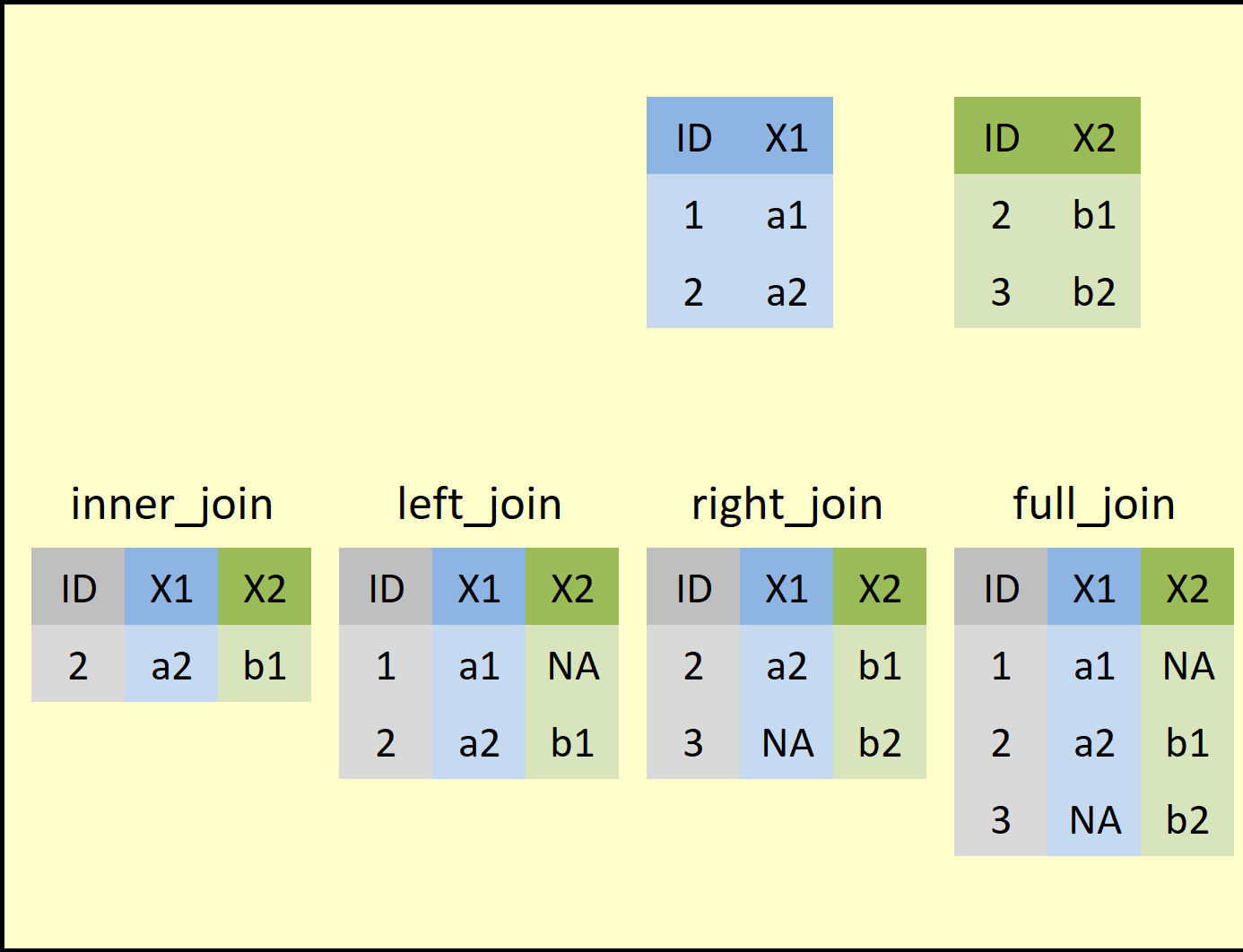
Here are the key ideas behind a join:
A join occurs between two tables: a “left” table and a “right” table. They’re called this just because we have to specify them in some order in our join command, so one will, by necessity, be to the “left” of the other.
-
The goal of a join is (usually) to make a “bigger” table by uniting related data found across the two smaller tables in some way. We’ll do that by:
Adding data from one table onto existing rows of the other table, making the receiving table wider (this is the idea behind left and right joins), or, in addition, by
Adding whole rows from one table to the other table that were “new” to the receiving table (that’s the idea behind a full join).
The exception is an inner join. An inner join will usually result in a smaller final table because we only keep, in the end, rows that had matches in both tables. Records that fail to match are eliminated.
-
But, wait, how do we know if data in one table “matches” data in another table and thus should be joined?
Well, because data found in the same row of a data set are usually related (they’re from the same country, person, group, etc.), relatedness is a “rowwise” question. We ask “which row(s) in this table are related to which row(s) in that table?”
Because computers can’t “guess” about relatedness, relatedness has to be explicit for a join to work: for rows to be considered related, they have to have matching values for one or more sets of key columns.
-
For example, in the picture above, consider the
IDcolumn that exists in both tables. If theIDcolumns were our key columns, row 1 in the left table, with itsIDvalue of1, would have no matching row in the right table (there is no row in that table with anIDvalue of1also). Thus, there is no new info in the right-hand table that could be added to the left-hand table for this row.- By contrast, row 2 in the left table, with its
IDvalue of2, does have a matching row in the right-hand table because its first row also has anIDvalue of2. Thus, we could combine these two rows in some way, either by adding new information from the right-hand table’s row to the left-hand table’s row or vice versa.
- By contrast, row 2 in the left table, with its
An analogy that might make this make relatable is to think of joins like combining jigsaw puzzle pieces. We can only connect together two puzzle pieces into something larger if they have corresponding “connectors;” matching key-column values are those connectors in a join.
Joins are a very powerful data manipulation—one many users
might otherwise have to perform in a language such as SQL. However,
dplyr possesses a full suite of joining functions,
including left_join() and right_join(),
full_join(), and inner_join(), to allow R
users to perform joins with ease.
Because a left join is the easiest form to explain and is also the
most commonly performed type of join, let’s use dplyr’s
left_join() function to add new information to every row of
the gapminder data set.
We’ll do this by first retrieving a new data set that
also possesses a column containing country names—this column
and the country column in our gapminder data
set will be our key columns; R will use them to figure
out which rows across the two data sets are related (i.e.,
they’ll share the same values in their country
columns).
We can make such a data set using the countrycode
package, so let’s install that package (if you don’t already have it),
turn it on, and check it out:
R
install.packages("countrycode") #ONLY RUN ONCE, ONLY IF YOU DON'T ALREADY HAVE THIS PACKAGE
OUTPUT
The following package(s) will be installed:
- countrycode [1.6.1]
These packages will be installed into "~/work/r-novice-gapminder/r-novice-gapminder/renv/profiles/lesson-requirements/renv/library/linux-ubuntu-jammy/R-4.4/x86_64-pc-linux-gnu".
# Installing packages --------------------------------------------------------
- Installing countrycode ... OK [linked from cache]
Successfully installed 1 package in 4.3 milliseconds.R
library(countrycode) #TURN ON THIS PACKAGE'S TOOLS
country_abbrs = countrycode(unique(gap$country), #LOOK UP ALL THE DIFFERENT GAPMINDER COUNTRIES IN THE countrycode DATABASE
"country.name", #FIND EACH COUNTRY'S NAME IN THIS DATABASE'S country.name COLUMN
"iso3c") #RETRIEVE EACH COUNTRY'S 3-LETTER ABBREVIATION
#COMPILE COUNTRY NAMES AND CODES INTO A NEW DATA FRAME
country_codes = data.frame(country = unique(gap$country),
abbr = country_abbrs)
head(country_codes)
OUTPUT
country abbr
1 Afghanistan AFG
2 Albania ALB
3 Algeria DZA
4 Angola AGO
5 Argentina ARG
6 Australia AUSThe data set we just constructed, country_codes,
contains 142 rows, one row per country found in our
gapminder data set. Each row contains a country name in the
country column and that country’s universally accepted
three-letter country code in the abbr column.
Now we can use left_join() to add that country code
abbreviation data to our gapminder data set, which doesn’t
already have it:
R
gap_joined = left_join(gap, country_codes, #THE "LEFT" TABLE GOES FIRST, AND THE "RIGHT" TABLE GOES SECOND
by = "country") #WHAT COLUMNS ARE OUR KEY COLUMNS?
head(gap_joined)
OUTPUT
country continent year lifeExp pop gdpPercap abbr
1 Afghanistan Asia 1952 28.801 8425333 779.4453 AFG
2 Afghanistan Asia 1957 30.332 9240934 820.8530 AFG
3 Afghanistan Asia 1962 31.997 10267083 853.1007 AFG
4 Afghanistan Asia 1967 34.020 11537966 836.1971 AFG
5 Afghanistan Asia 1972 36.088 13079460 739.9811 AFG
6 Afghanistan Asia 1977 38.438 14880372 786.1134 AFGHere’s what happened in this join:
R looked at the left-hand table and found all the unique values in its key column,
country.Then, for each unique value it found, it scanned the right-hand table’s key column (also called
country) for matches. Does any row over here on the right contain acountryvalue that matches thecountryvalue I’m looking for in the left-hand table?Whenever it found a match (e.g., a left-hand row and a right-hand row were both found to contain
"Switzerland"), then R asked “What stuff exists in the right-hand table’s row that isn’t already in the left-hand table’s row?”The non-redundant stuff was then copied over to the left-hand table’s row, making it wider. In this case, that was just the
abbrcolumn.
While a little hard to wrap one’s head around, joins are a powerful way to bring multiple data structures together, provided they share enough information to link their rows meaningfully!
Key Points
- Use the
dplyrpackage to manipulate data frames in efficient, clear, and intuitive ways. - Use
select()to retain specific columns when creating subsetted data frames. - Use
filter()to create a subset by rows using logical tests to determine whether a row should be kept or gotten rid of. - Use
group_by()andsummarize()to generate summaries of categorical groups within a data set. - Use
mutate()to create new variables using old ones as inputs. - Use
rename()to rename columns. - Use
arrange()to sort your data set by one or more columns. - Use pipes (
%>%) to stringdplyrverbs together into “paragraphs.” - Remember that order matters when stringing together
dplyrverbs!
Publication-quality graphics with ggplot2
Overview
Questions
- What are the most common types of operations someone might perform on a data frame in R?
- How can you perform these operations clearly and efficiently?
Objectives
Recognize the four essential “ingredients” that go into every ggplot graph.
Map aesthetics (visual components of a graph like axis, color, size, line type, etc.) to columns of your data set or to constant values.
Contrast applying settings globally (in
ggplot()), where they will apply to every component of the graph, versus locally (within ageom_*()function), where they will apply only to that one component.Use the
scale_*()family of functions to adjust the appearance of an aesthetic, including axis/legend titles, labels, breaks, limits, colors, and more.Use
theme()to adjust the appearance of any text box, line, or rectangle in your ggplot.Understand how the order of components in a ggplot command affects the final product, including how conflicts between competing instructions get resolved.
Use faceting to divide a complex graphic into sub-panels.
Write graphs to disk as image files with the desired characteristics.
Overview
Questions
- How do scientists produce publication-quality graphs using R?
- What’s it take to build a graph “from scratch,” component by component?
- What’s it mean to “map an aesthetic?”
- Which parts of a ggplot command (both required and optional) control which aspects of plot construction? When I want to modify an aspect of my graphic, how will I narrow down which component is responsible for that aspect?
- How do I save a finished graph?
- What are some ways to put my unique “stamp” on a graph?
Objectives
Recognize the four essential “ingredients” that go into every ggplot graph.
Map aesthetics (visual components of a graph like axis, color, size, line type, etc.) to columns of your data set or to constant values.
Contrast applying settings globally (in
ggplot()), where they will apply to every component of the graph, versus locally (within ageom_*()function), where they will apply only to that one component.Use the
scale_*()family of functions to adjust the appearance of an aesthetic, including axis/legend titles, labels, breaks, limits, colors, and more.Use
theme()to adjust the appearance of any text box, line, or rectangle in your ggplot.Understand how the order of components in a ggplot command affects the final product, including how conflicts between competing instructions get resolved.
Use faceting to divide a complex graphic into sub-panels.
Write graphs to disk as image files with the desired characteristics.
Introduction
When scientists first articulate their ideas for a research project, they often do so by drawing a graph of the results they expect to observe after performing a test (a “prediction graph”). When they have acquired new data, one of the first things they often do is make graphs of those data (“exploratory graphs”). And, when it’s time to summarize and communicate project findings, graphs play a key role in those processes too. Graphs lie at the heart of the scientific process!
Base R possesses a plotting system, though it is a little rudimentary and has limited customization features. Other packages, such as lattice, have added additional graphics options to R. However, no other graphics package is as widely used nor (arguably) as powerful as ggplot2.
Based on the so-called “grammar of graphics” (the “gg” in ggplot),
ggplot2 allows R users to produce highly detailed, richly
customizable, publication-quality graphics by providing a vocabulary
with which to build a complex, bespoke graph piece by painstaking
piece.
Because graphs can take on a dizzying number of forms and
have myriad possible customizations—all of which ggplot2
makes possible—the package has a learning curve for sure! However, by
linking each component of a ggplot command (both optional and required)
to its purpose and purview, we can learn to view building a ggplot as
little different from building a pizza, and nearly everyone can build
one of those!
After all, the idea at the heart of ggplot2 is that a
graph, no matter the type or style or complexity, should be
buildable using the same general set of tools and workflow,
even if there are modest and particular deviations required. Once we
understand those tools and that workflow, we’ll be well on our way to
producing graphs as stellar as those we see in our favorite
publications!
The four required components of every ggplot graph
Let’s begin by introducing the four required components every
ggplot2 graph must have. These are:
A
ggplot()call.A geometry layer.
A data frame (or tibble, or equivalent) of data to graph.
Mapping one or more aesthetics.
The first of these is, arguably, the most essential—nothing will happen without it. Let’s see what it does:
R
ggplot()
When you run this command, you should see a blank, gray window appear in your RStudio Viewer pane (or, perhaps, elsewhere, depending upon your settings):

The ggplot() function creates an empty “plotting
window,” a container that can eventually hold the plot we
intend to create. By analogy, if building a ggplot is like building a
pizza, the ggplot() call creates the crust, the first and
bottom-most layer, without which a pizza cannot really exist at all.
The other purpose of the ggplot() call is to allow us to
set global settings for our ggplot. However, let’s come
back to that idea a little later.
In the meantime, let’s move on to the second essential component of a ggplot: a data set. It should hopefully make sense that, without data, there can be no graph!
So, we need to provide data as inputs to our ggplot command somehow. We actually have options for this. We could:
Provide our data set as the first input to
ggplot()(the “standard” way), orProvide our data set as the first input to one (or more) of the
geom_*()functions we’ll add to our command.
For this lesson, we’ll always add our data via
ggplot(), but, later, I’ll mention why you might
considering doing things the “non-standard” way sometimes.
For now, let’s provide our gapminder data set to our
ggpl``ot() call’s first parameter, data:
R
ggplot(data = gap)

You’ll notice nothing has changed—our window is still empty. This should actually make sense; we’ve told R what data we want to graph, but not which exact data, where we want them, or how we want them drawn. In our pizza-building analogy, we’ve shown R the pantry and refrigerator and utensil drawers, full of available toppings and tools, but we haven’t requested anything specific yet.
Callout
Notice that the first parameter slot in ggplot() (and in
the geom_*() functions as well) is the slot for our
data set. This is purposeful; ggplot() can
accept the final product of a dplyr “paragraph” built using
pipes!
The third requirement of every ggplot is that we need to map one or more aesthetics. This is a fancy way of saying “This is thedata to graph and this is where to put them (although”where” here is not always the perfect word, as we’ll see).”
For example, when we want to plot the data found in a specific column
of our data set (e.g., those in the lifeExp
column), we communicate this to R by linking (mapping)
that column’s name to the name of the appropriate aesthetic of our
graph. We do this using the aes() function, which expects
us to use aesthetic = column name format.
This’ll be clearer with an example. Let’s make a
scatterplot of each country’s GDP per capita
(gdpPercap) on the x-axis versus its life expectancy
(lifeExp) value on the y-axis. Here’s how we can do
this:
R
ggplot(data = gap,
mapping = aes(x = gdpPercap, y = lifeExp)) #<-USE AESTHETIC = COLUMN NAME FORMAT INSIDE aes()
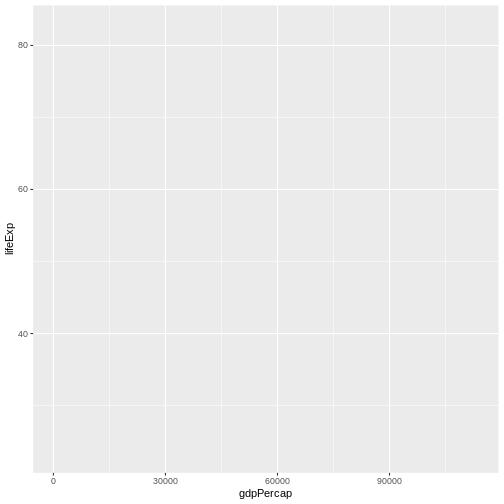
With this addition, our graph looks very different—we now have axes, axes labels, axes titles, grid lines, etc. This is because R now knows which data in our data set to plot and which aesthetics (“dimensions”) we want them linked to (here, the x- and y-axes).
In our pizza-building analogy, you can think of aesthetics mapping as the “sauce.” It’s another base layer that is necessary and fundamentally ties the final product together, but more is needed before we have a complete, servable product.
What’s still missing? R knows what data it should plot now and where, but still isn’t plotting them. That’s because it doesn’t know how we want them plotted. Consider that we could represent the same raw data on a graph using many different shapes (or “geometries”): points, lines, boxes, bars, wedges, and so forth. So far as R knows, we could be aiming for a scatterplot here, but we could also be aiming for a line graph, or a boxplot, or some other format.
Clearing up this ambiguity is what our geom_*()
functions are for, the fourth and final required component of a ggplot.
They specify the geometry (shape) we want the data to
take. Because we’re trying to build a scatterplot of
points, we will add the geom_point()
function to our command. Note that we literally add
this call—ggplot2 uniquely uses the + operator
to add components to the same ggplot command, somewhat similar to how
dplyr tacks multiple commands together into a single
command with the pipe operator:
R
ggplot(data = gap,
mapping = aes(x = gdpPercap, y = lifeExp)) + #<--NOTE THE + OPERATOR
geom_point()
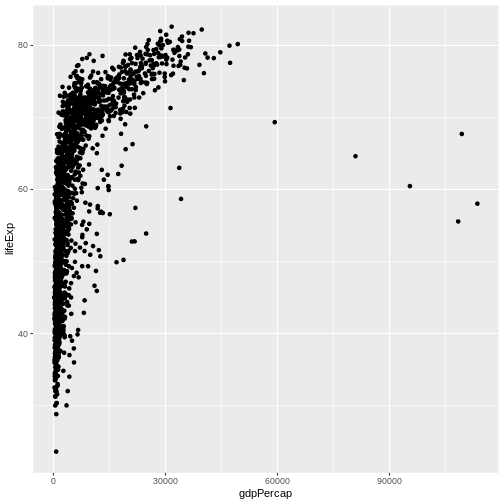
Now that we’ve added all four essential components to our command, we finally receive a complete (albeit basic) scatterplot of GDP versus life expectancy. In our pizza-building analogy, adding one (or more) geometries (or geoms for short) is like adding cheese to the pizza. Sure, we could add more to a pizza than just cheese and do more things to make it much fancier, but a basic cheese pizza is a complete product we could eat if we wanted!
Challenge
Modify the previous command to produce a scatterplot that shows how life expectancy changes over time instead.
The gapminder data set has a column, year,
containing time data. We can swap that column in for
gdpPercap for the x aesthetic inside of our
aes() function to achieve this goal:
R
ggplot(data = gap,
mapping = aes(x = year, y = lifeExp)) + #<--SWAP X VARIABLE
geom_point()
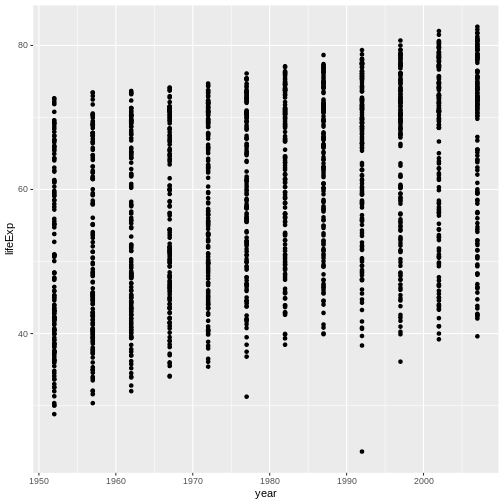
This shows that even just understanding the required components of a ggplot command allows you to make tons of different graphs by mixing and matching inputs!
Challenge
Another popular ggplot aesthetic that can be
mapped to a specific column is color (why
“where” isn’t always the best term for describing aesthetics…thinking of
them as “dimensions” is probably more accurate!).
Modify the code from the previous exercise so that points are colored
according to continent.
We can add a color input to our aes() call
using aesthetic = column format like so:
R
ggplot(data = gap,
mapping = aes(x = year, y = lifeExp, color = continent)) + #<--ADD THIRD AESTHETIC
geom_point()
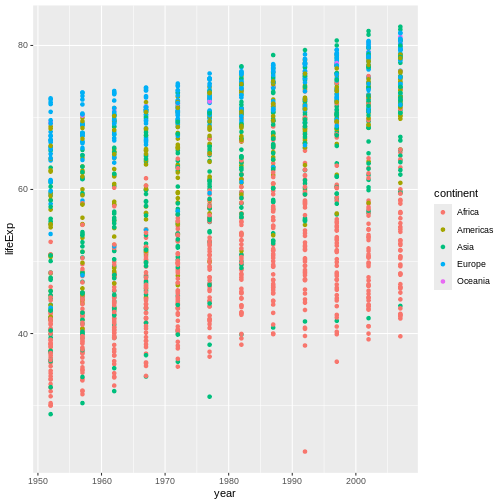
This graph now shows that, while countries in Europe
tend to have high life expectancy values, the values of countries in
Africa tend to be lower, so this one modification
has added considerable value and interest to our plot.
There are dozens of aesthetics that can be mapped within
ggplot2 besides x, y, and
color, including fill, group,
z (for 3D graphs), size, alpha
(transparency), linetype, linewidth, and many
more.
Getting a little fancy
If we can create a very different graph just by adding or subtracting an aesthetic or swapping an existing aesthetic for another, it stands to reason that we can also create a very different graph by swapping the geom(s) we’re using.
Because it doesn’t actually make a lot of sense to examine changes
over time using a scatterplot, let’s change to a line graph instead.
This drastic conceptual change requires only a small
coding change; we swap geom_point() for
geom_line():
R
ggplot(data = gap,
mapping = aes(x = year, y = lifeExp, color = continent)) +
geom_line() #<-SWAP GEOMS
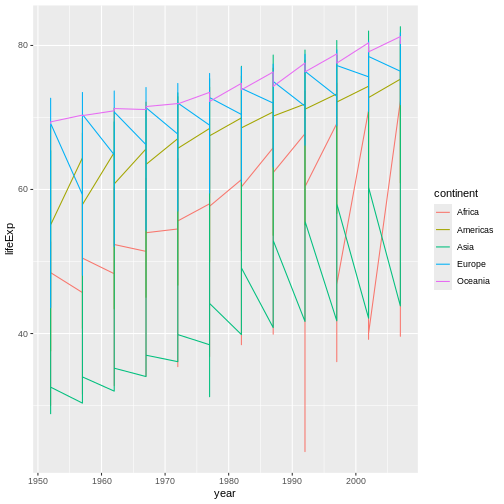
This is a very different graph than the previous one! In our pizza-building analogy, adjusting geoms is like adjusting the cheese you’re topping the pizza with. Ricotta and Parmesan and Mozzarella (and blends of these) are all very different and yield pizzas with very different “flairs,” even though the result is still a cheese pizza.
Discussion
Now, admittedly, our graph looks a little…odd. It’s probably not
immediately obvious just from looking at it, but R is currently
connecting every data point from each continent, regardless
of country, with a single line. Why do you think it’s doing that?
It’s doing this because we have specified a grouping
aesthetic—color. That is, we have mapped an
aesthetic, color, to a variable in our data set that is
categorical (or discrete) in nature rather than continuous (numeric).
When we do that, we explicitly ask R to divide our data into discrete
groups for that aesthetic. It will then assume it should do the same for
any other aesthetics or features where that same division makes
sense.
So, when R goes to draw lines, it thinks “Hmm, if they want discrete colors by continent, maybe they also want discrete lines by continent too.”
Conceptually, it probably makes more sense to think about how life
expectancy is changing per country, not per
continent, even though it still might be interesting to
consider how countries from different continents compare.
Is there a way to keep the colors as they are but separate the lines by
country?
Yes! If you want to group in one way for one aesthetic
(e.g., different colors for different continents)
but in a different way for all other aesthetics (e.g., have one
line ber country), we can make this distinction using the
group aesthetic. A ggplot will group according to the
group aesthetic for every aesthetic not explicitly grouped
in some other way:
R
ggplot(data = gap,
mapping = aes(x = year, y = lifeExp,
color = continent, group = country)) + #GROUP BY COUNTRY FOR EVERYTHING BUT COLOR
geom_line()
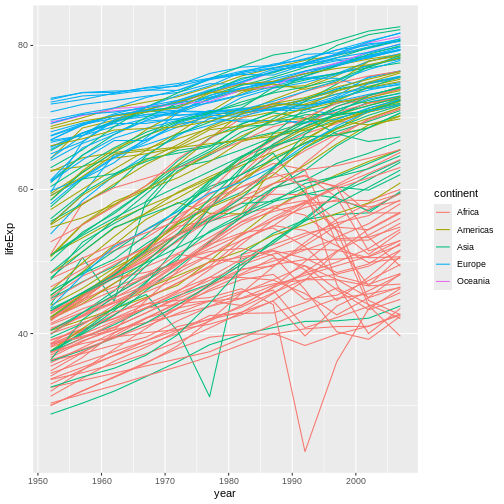
Now, we have a separate line for each country, which is probably what we were expecting to receive in the first place and is also a more nuanced way to look at the data than what we had before.
Earlier, I noted that while it’s possible to have a pizza with just one kind of cheese, you can also have a pizza featuring a blend of cheeses. Similarly, you can produce a ggplot with a blend of geoms. Let’s add points back to this graph to see this:
R
ggplot(data = gap,
mapping = aes(x = year, y = lifeExp,
color = continent, group = country)) +
geom_line() +
geom_point() #CAN HAVE MULTIPLE GEOMS

This graph now features both the lines and the points they connect. Is this better, or is it just busier? That’s for you to decide!
Challenge
Before we move on, there are two more aesthetics I want you to try
out: size and alpha. Try mapping
size to the pop column. Then, try mapping
alpha to a constant value of 0.3 (its default
value is 1 and it must range between 0 to
1). Remove the geom_line() call from your code
for now to make the effects of each change easier to see. What does each
of these aesthetics do?
size controls the size of the points plotted (the
equivalent for lines is linewidth):
R
ggplot(data = gap,
mapping = aes(x = year, y = lifeExp,
color = continent, group = country,
size = pop)) + #ADD SIZE AND LINK IT TO POPULATION
# geom_line() +
geom_point()
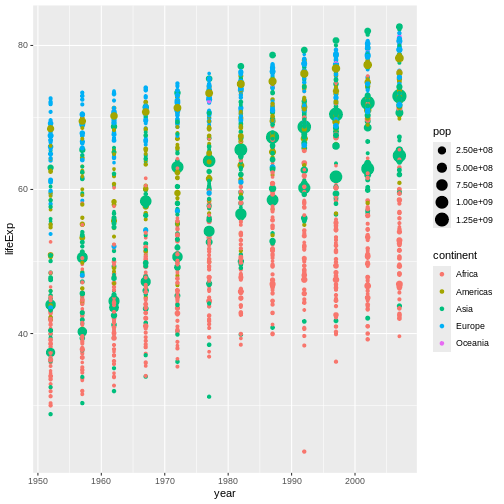
Now, countries with bigger population values also have larger points. This would now be called a bubble plot, and it’s one of my all-time favorite graph types!
Meanwhile, alpha controls the transparency of
elements, with lower values being more transparent:
R
ggplot(data = gap,
mapping = aes(x = year, y = lifeExp,
color = continent, group = country,
alpha = 0.3)) + #SWAP FOR ALPHA
# geom_line() +
geom_point()
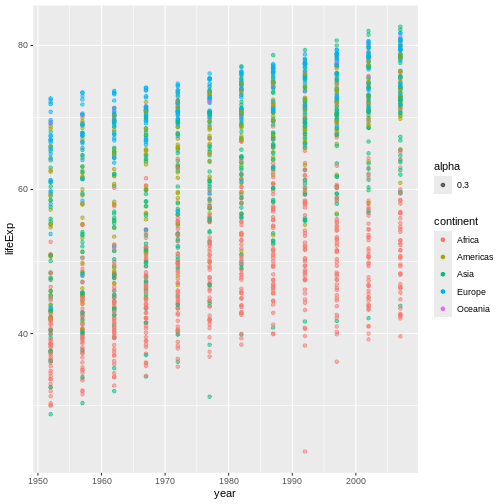
The effect is subtle here, but individual points are now pretty faint. Where there are many points in the same location, however, they stack on top of each other and add their alphas, resulting in a more opaque-looking dot. This allows viewers to still get a sense of “point density” even when many points would otherwise be plotted in the exact same place.
Further, when multiple points of different colors are
stacked together, their colors blend, making it more obvious
which points are stacking. As such, adjusting
alpha is a great way to add depth and nuance to a graph
that might be too “busy” to afford much otherwise!
Global vs local settings, order effects, and mapping aesthetics to constants
Perhaps you don’t like the fact that the points are also colored by continent—you’d prefer them to just be all black. However, you’d like to keep the lines colored as they are. Is this achievable?
Yes! In fact, we actually have two options to achieve it, and they relate to the two ways we can map aesthetics:
We can map a column’s data to a specific aesthetic using the
aes()function, orWe can map an aesthetic to a constant value.
Up til now, we’ve only done the first. However, here, one way to
achieve our desired outcome is to do the second. Inside
geom_point(), we could set the color aesthetic to the
constant value "black":
R
ggplot(data = gap,
mapping = aes(x = year, y = lifeExp,
color = continent, group = country)) +
geom_line() +
geom_point(color = "black") #OVERRIDE THE COLOR RULES FOR THIS GEOM ONLY, SETTING THIS VALUE TO A CONSTANT
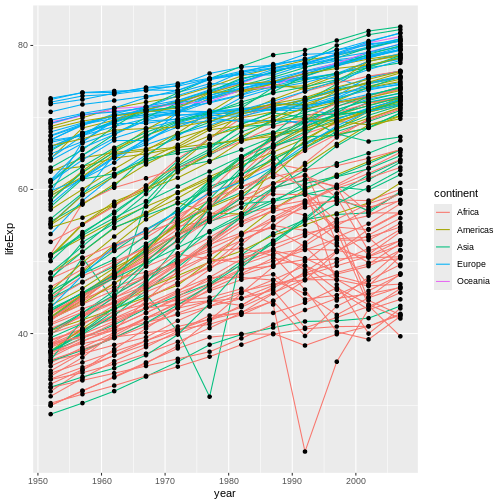
Now our points are black, but our lines remain colored by continent. Why does this work?
Callout
There are two key ggplot2 concepts revealed by this
example:
When you want to set an aesthetic to a specific, constant value, you don’t need to use the
aes()function (although we can–it’d work either way). Instead, you can simply use aesthetic = constant format.When an aesthetic has been mapped twice such that there’s a conflict (we’ve set the color of points to both
continentand to"black"here), the second mapping takes precedence. Because our second mapping setting point color to"black", that’s what happens.
However, this was not the only way to achieve this outcome. Because
"black" is the default color value already, and because we
want colors to be mapped to continents for
only our lines, we could instead map the color
aesthetic to continents just inside
geom_line(), like this:
R
ggplot(data = gap,
mapping = aes(x = year, y = lifeExp, group = country)) +
geom_line(mapping = aes(color = continent)) + #MOVE MAPPING OF THIS ONE AESTHETIC TO THE GEOM SO IT'LL ONLY APPLY THERE.
geom_point()
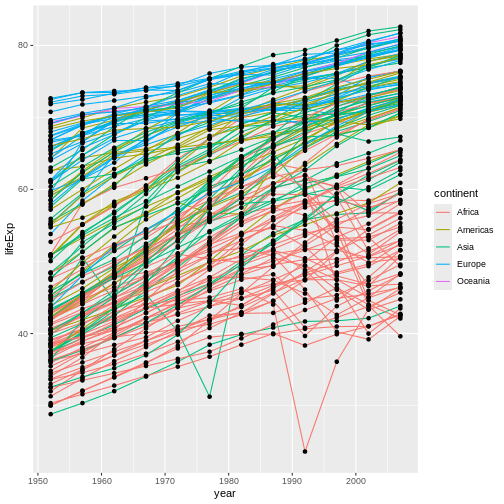
Callout
This approach, though quite different-looking, has the same net
effect: Our lines are colored by continent, but our points
remain black (the default). This demonstrates a third key
ggplot2 concept: Data sets can be provided, and aesthetics
can be mapped, either “globally” inside of ggplot() or else
“locally” inside of a geom_*() function.
In other words, if we do something inside ggplot(), that
thing will apply to every (relevant) component of our graph.
For example, by providing our data set inside ggplot(),
every subsequent component (our aes() calls, our
geom_point(), and our geom_line()) all assume
we are referencing that one data set.
Instead, we could provide one data set to geom_point()
and a completely different one to geom_line(), if
we wanted to (i.e., we could provide data “locally”). Each geom
would then use only the data it was provided. So long as the
two data sets are compatible enough, R’ll find a way to render
both layers on the same graph!
By managing which information we provide “globally” versus “locally,” we can heavily customize how we want our graph to look (its aesthetics) and the data each component references. In our pizza-building analogy, this is like how cheese and toppings can either be applied to the whole pizza evenly or in differing amounts for each “half” or “quarter,” if we want each slice of our pizza to be a different experience!
Challenge
There’s another key ggplot2 concept to learn at this
stage. Compare the graph above to the one produced by the code
below:
R
ggplot(data = gap,
mapping = aes(x = year, y = lifeExp, group = country)) +
geom_point() +
geom_line(mapping = aes(color = continent))
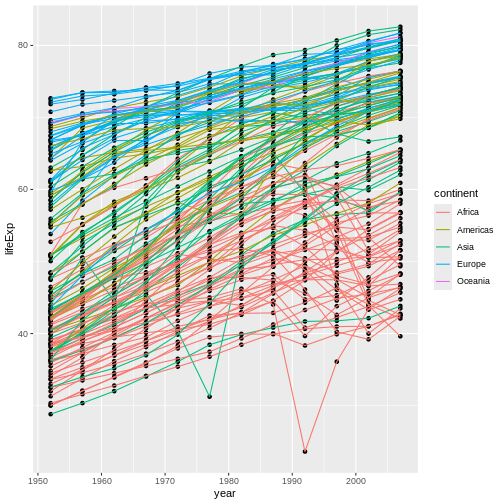
In what way does this graph look different than the previous one? Why does it look different?
This second graph looks different in that our points are now underneath our lines whereas, before, they were on top of our lines.
The reason behind this difference is that we’ve swapped the order of
our geom_*() calls. Before, we called
geom_point() second; now, we’re calling it first.
This matters because ggplot2 adds layers of information
to our graph (such as our geoms) in the order in which those layers are
specified in the command, with earlier layers going on the “bottom” and
later layers going “on top.” By specifying geom_line()
second, we have instructed R to first plot points,
then plot lines, covering up the points beneath wherever
relevant.
In our pizza-building analogy, this is the same as when toppings are added—order matters! If we add pepperoni first, then cheese, our pepperoni will be present, but it’ll be buried and not visible. If we add it second, though, it’ll be visible (and less cheese will be), but it could also burn! So, which approach is better depends on the circumstances and on your preferences as well.
Customizing our aesthetics using the style_*() functions
Already, we know quite a lot about how to make an impressive ggplot!
However, there may still be several design aspects of our graph we may find dissatisfying. For example, the axes and legend titles look exactly like the names of the columns in our data set instead of something more polished. How can we change those?
Well, we could change the column names in our data set to
something more polished, which would fix the problem, but we don’t
have to do that. Whenever we want to adjust the look
of one of our graph’s mapped aesthetics, especially the axes and the
legend, we can use a scale_*() family function.
If you go to your R Console and start typing scale_ and
wait, a pop-up will appear that contains dozens and dozens of functions
that all start with scale_. There are a lot of
these functions! Which ones do we need to use?
Thankfully, all these functions follow the same naming convention, making choosing the right one less of a chore: scale_[aesthetic]_[datatype]. The second word in the function name clarifies which aesthetic we are trying to adjust and the third word clarifies what type of data is currently mapped to that aesthetic (R can’t do the exact same things to a grouping aesthetic as it would for a continuous one, e.g.).
For example, say that we wanted to reformat our x-axis’ title.
Because the x axis is mapped to continuous data, we can use the
scale_x_continuous() function to adjust its appearance.
This function’s first parameter, name, is the name we want
to use for this axis’ title:
R
#REMOVE geom_point() FOR SIMPLICITY!
ggplot(data = gap,
mapping = aes(x = year, y = lifeExp, group = country)) +
geom_line(mapping = aes(color = continent)) +
scale_x_continuous(name = "Year") #<-SPECIFY NEW AXIS TITLE
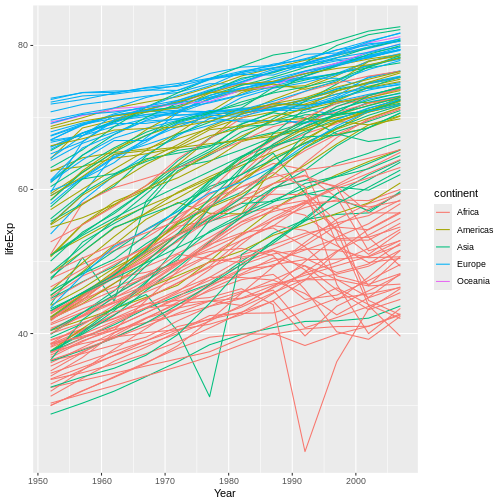
Our x-axis title is now more polished-looking—even just having a capital letter makes a difference!
Challenge
Modify the code above to replace the y-axis’ title with
"Life expectancy (years)".
Our y data are also continuous, so we can use the
scale_y_continuous() function to adjust this axis’
title:
R
ggplot(data = gap,
mapping = aes(x = year, y = lifeExp, group = country)) +
geom_line(mapping = aes(color = continent)) +
scale_x_continuous(name = "Year") +
scale_y_continuous(name = "Life expectancy (years)") #WE CAN USE AS MANY SCALE FUNCTIONS AS WE WANT IN A SINGLE COMMAND.
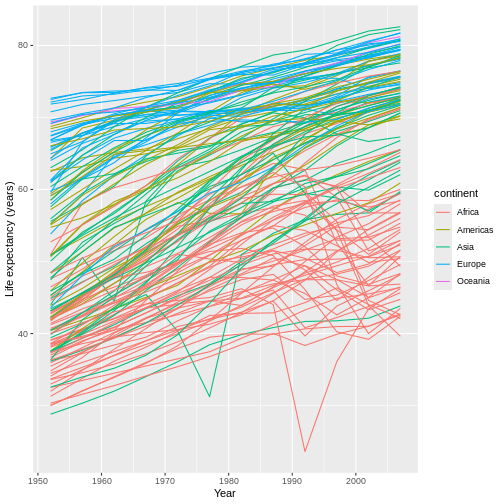
We can do something similar for the legend title. However, because
our legend is clarifying the different colors on the graph, we
have to use a scale_color_*() function this time. Also,
this aesthetic is mapped to grouping (or categorical, or
discrete) data, so we’ll need to use the
scale_color_discrete() function:
R
ggplot(data = gap,
mapping = aes(x = year, y = lifeExp, group = country)) +
geom_line(mapping = aes(color = continent)) +
scale_x_continuous(name = "Year") +
scale_y_continuous(name = "Life expectancy (years)") +
scale_color_discrete(name = "Continent")
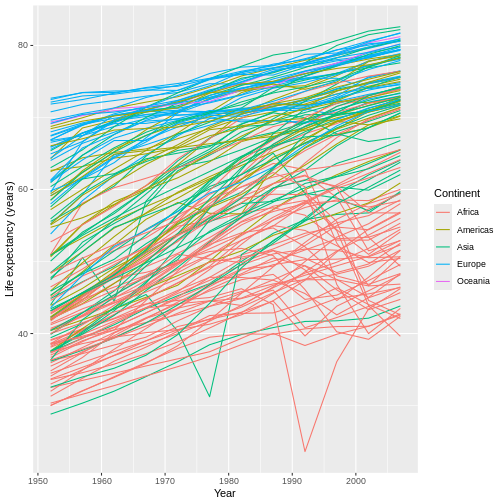
The scale_*() functions can also be used to adjust axis
labels, axis limits, legend keys, colors, and more.
For example, have you noticed that the x axis labels run from 1950 to 2000, leaving a large gap between the last label and the right edge of the graph? I personally find that gap unattractive. We can eliminate it by first expanding the limits of the x-axis out to 2010:
R
ggplot(data = gap,
mapping = aes(x = year, y = lifeExp, group = country)) +
geom_line(mapping = aes(color = continent)) +
scale_x_continuous(name = "Year", limits = c(1950, 2010)) + #MIX, MAX
scale_y_continuous(name = "Life expectancy (years)") +
scale_color_discrete(name = "Continent")
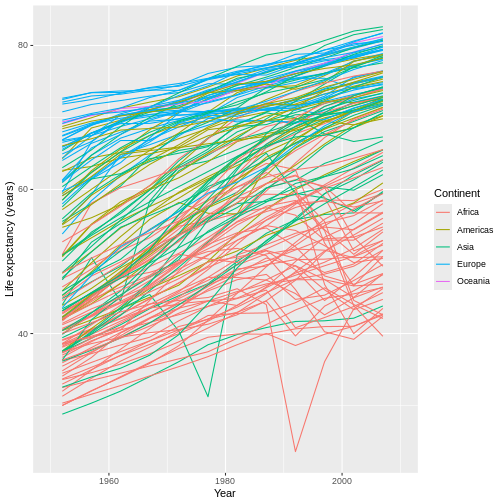
This automatically adjusts the breaks of the axis (at what values the labels get put), which actually makes the problem worse! However, we can then add a set of custom breaks to tell R exactly where it should put labels on the x-axis:
R
ggplot(data = gap,
mapping = aes(x = year, y = lifeExp, group = country)) +
geom_line(mapping = aes(color = continent)) +
scale_x_continuous(name = "Year",
limits = c(1950, 2010),
breaks = c(1950, 1970, 1990, 2010)) + #HOW MANY LABELS, AND WHERE?
scale_y_continuous(name = "Life expectancy (years)") +
scale_color_discrete(name = "Continent")
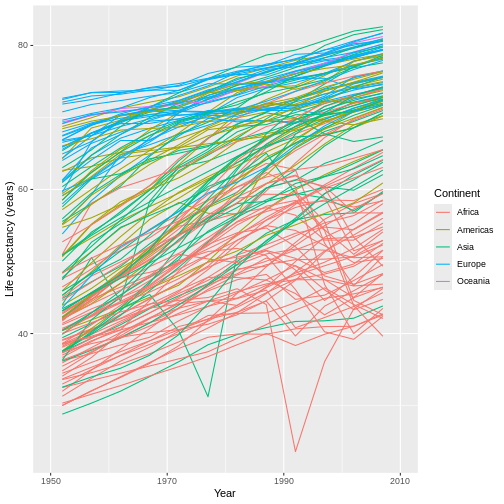
You can specify as many (or as few) breaks as you’d like, and they
don’t have to be equidistant! Further, while
breaks affects where the labels occur, the
labels parameter can additionally affect what they
say, including making them text instead of numbers. So, we
could do something kind of wild like this:
R
ggplot(data = gap,
mapping = aes(x = year, y = lifeExp, group = country)) +
geom_line(mapping = aes(color = continent)) +
scale_x_continuous(name = "Year",
limits = c(1950, 2010),
breaks = c(1950, 1970, 1990, 2000, 2010), #ADD 2000 AS A BREAK
labels = c(1950, 1970, 1990, "Y2K", 2010)) + #MAKE ITS LABEL "Y2K"
scale_y_continuous(name = "Life expectancy (years)") +
scale_color_discrete(name = "Continent")
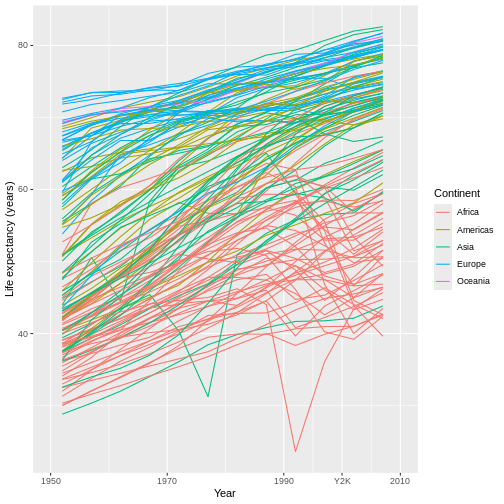
There are so many more things that each scale_*()
function can do! Check their help pages for more details:
R
?scale_x_continuous()
As one final example, note that we can also use
scale_color_discrete() to specify new colors for our graph
to use for its continent groupings:
R
ggplot(data = gap,
mapping = aes(x = year, y = lifeExp, group = country)) +
geom_line(mapping = aes(color = continent)) +
scale_x_continuous(name = "Year",
limits = c(1950, 2010),
breaks = c(1950, 1970, 1990, 2000, 2010), #ADD 2000
labels = c(1950, 1970, 1990, "Y2K", 2010)) + #CALL IT "Y2K"
scale_y_continuous(name = "Life expectancy (years)") +
scale_color_discrete(name = "Continent",
type = c("plum", "gold", "slateblue2", "chocolate2", "lightskyblue")) #WHY THIS PARAMETER IS CALLED TYPE IS A MYSTERY :)
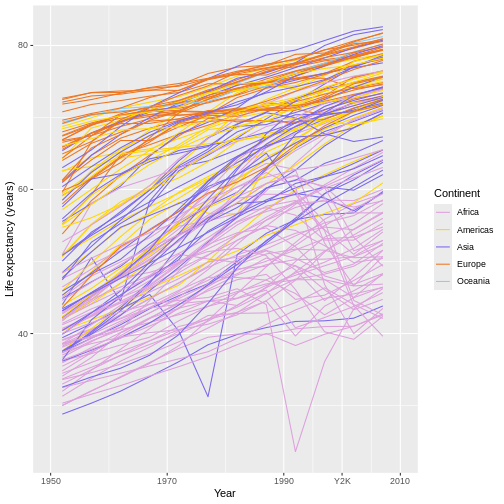
Let’s just hope you have better taste in colors than I do! 😂
Customizing lines, rectangles, and text using theme()
You may also have noticed that our graph’s background is gray with
white grid lines, our text is rather small, and our x- and y-axes are
missing lines. Because each of these components is a line, a text box,
or a rectangle, they fall under the purview of the theme()
function.
At the RStudio Console, type theme() and hit tab while
your cursor is inside of theme()’s parentheses. A popup
will appear that shows all the parameters that
theme() has. It’s a lot! All of these correspond
to text-based, rectangular, and linear components of your graph that you
can modify the appearance of using theme(). Half the battle
of using theme() properly, then, is just figuring out the
name of the component you’re trying to adjust!
Let’s start with those grid lines in the background. In general,
publication-quality graphics don’t have grid lines, even though
ggplot2 adds them by default, so let’s remove them. Inside
of theme(), the major grid lines are controlled by the
panel.grid.major parameter, and, to remove an element like
these from a graph, we can assign its parameter a call to the
element_blank() function:
R
ggplot(data = gap,
mapping = aes(x = year, y = lifeExp, group = country)) +
geom_line(mapping = aes(color = continent)) +
scale_x_continuous(name = "Year",
limits = c(1950, 2010),
breaks = c(1950, 1970, 1990, 2000, 2010),
labels = c(1950, 1970, 1990, "Y2K", 2010)) +
scale_y_continuous(name = "Life expectancy (years)") +
scale_color_discrete(name = "Continent") +
theme(panel.grid.major = element_blank()) #THIS ELIMINATES THIS ASPECT OF THE GRAPH
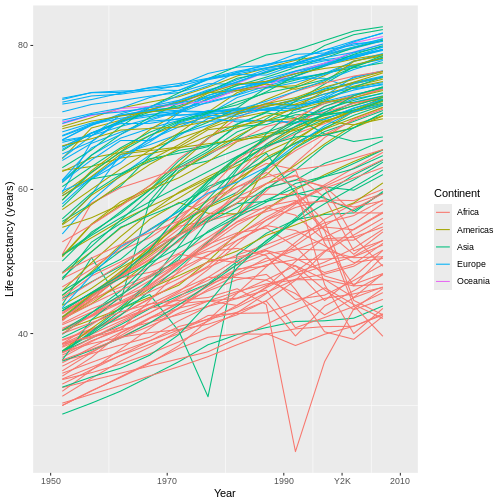
…Unfortunately, ggplots come with both major and minor grid lines, so we have to eliminate the latter also:
R
ggplot(data = gap,
mapping = aes(x = year, y = lifeExp, group = country)) +
geom_line(mapping = aes(color = continent)) +
scale_x_continuous(name = "Year",
limits = c(1950, 2010),
breaks = c(1950, 1970, 1990, 2000, 2010),
labels = c(1950, 1970, 1990, "Y2K", 2010)) +
scale_y_continuous(name = "Life expectancy (years)") +
scale_color_discrete(name = "Continent") +
theme(panel.grid.major = element_blank(),
panel.grid.minor = element_blank())
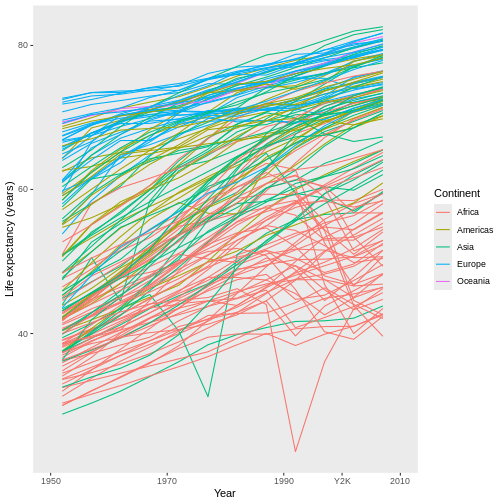
Alternatively, the major and minor grid lines are also jointly
controlled by the panel.grid parameter—setting this one to
element_blank() would remove both at once:
R
ggplot(data = gap,
mapping = aes(x = year, y = lifeExp, group = country)) +
geom_line(mapping = aes(color = continent)) +
scale_x_continuous(name = "Year",
limits = c(1950, 2010),
breaks = c(1950, 1970, 1990, 2000, 2010),
labels = c(1950, 1970, 1990, "Y2K", 2010)) +
scale_y_continuous(name = "Life expectancy (years)") +
scale_color_discrete(name = "Continent") +
theme(panel.grid = element_blank())
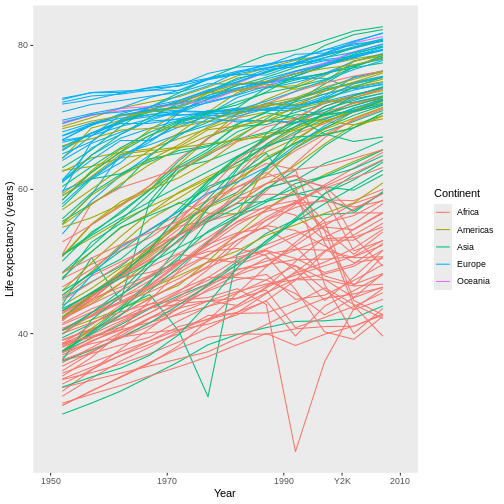
This emphasizes a general rule with theme(): Often,
there are parameters that control individual elements (such as just the
x-axis or y-axis line) and also parameters that control whole groups of
elements (such as all the axis lines at once).
For example, if we want to increase the size of all the text
in the graph, we can use the text parameter. Because all
the text in our graph is, well, text, we modify it by using the
element_text() function:
R
ggplot(data = gap,
mapping = aes(x = year, y = lifeExp, group = country)) +
geom_line(mapping = aes(color = continent)) +
scale_x_continuous(name = "Year",
limits = c(1950, 2010),
breaks = c(1950, 1970, 1990, 2000, 2010),
labels = c(1950, 1970, 1990, "Y2K", 2010)) +
scale_y_continuous(name = "Life expectancy (years)") +
scale_color_discrete(name = "Continent") +
scale_color_discrete(name = "Continent") +
theme(panel.grid = element_blank(),
text = element_text(size = 16)) #WE PUT OUR NEW SPECIFICATIONS INSIDE THE element_*() FUNCTION
OUTPUT
Scale for colour is already present.
Adding another scale for colour, which will replace the existing scale.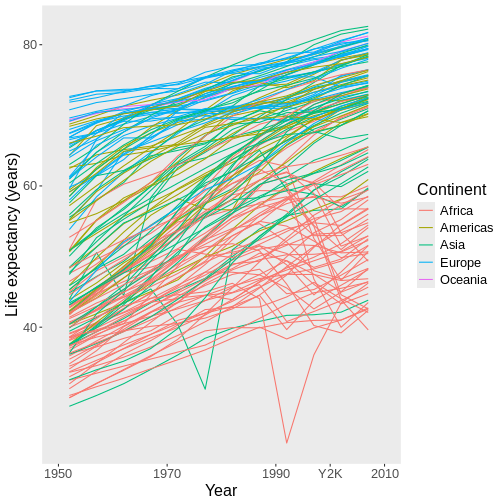
Now our text is much more readable for those with impaired vision!
However, if we wanted to further increase the size of just the axis
title text and also make it bold, we could again use
element_text() but target the axis.title
parameter, which targets just those two text boxes and no others:
R
ggplot(data = gap,
mapping = aes(x = year, y = lifeExp, group = country)) +
geom_line(mapping = aes(color = continent)) +
scale_x_continuous(name = "Year",
limits = c(1950, 2010),
breaks = c(1950, 1970, 1990, 2000, 2010),
labels = c(1950, 1970, 1990, "Y2K", 2010)) +
scale_y_continuous(name = "Life expectancy (years)") +
scale_color_discrete(name = "Continent") +
theme(panel.grid = element_blank(),
text = element_text(size = 16),
axis.title = element_text(size = 18, face = "bold")) #ANY CONFLICTS GET "WON" BY THE LAST RULE SET.
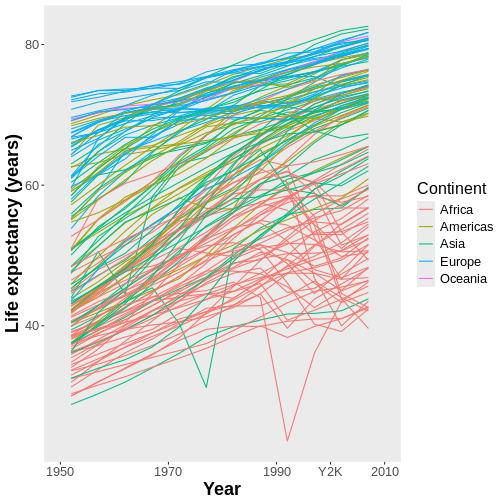
Next, what if we don’t care for the gray background on our graph?
Because that’s a rectangle, we can control it using the
element_rect() function, and the parameter in charge of
that rectangle is panel.background:
R
ggplot(data = gap,
mapping = aes(x = year, y = lifeExp, group = country)) +
geom_line(mapping = aes(color = continent)) +
scale_x_continuous(name = "Year",
limits = c(1950, 2010),
breaks = c(1950, 1970, 1990, 2000, 2010),
labels = c(1950, 1970, 1990, "Y2K", 2010)) +
scale_y_continuous(name = "Life expectancy (years)") +
scale_color_discrete(name = "Continent") +
theme(panel.grid = element_blank(),
text = element_text(size = 16),
axis.title = element_text(size = 18, face = "bold"),
panel.background = element_rect(fill = "white"))
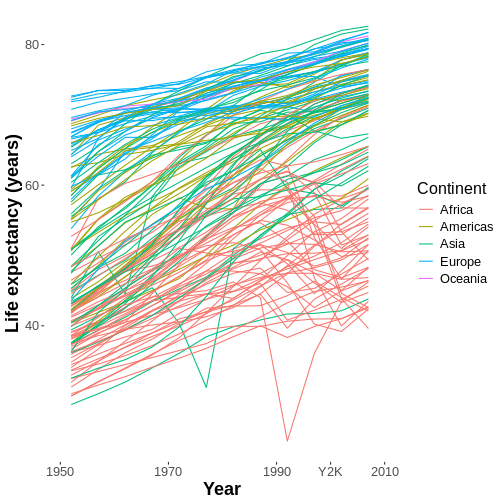
That looks cleaner to me! But it still feels very odd for there to be
no x- and y-axis lines. Let’s add some! Because those lines are, well,
lines, we can control those using the
element_line() function, and the parameter in control of
both lines together is axis.line:
R
ggplot(data = gap,
mapping = aes(x = year, y = lifeExp, group = country)) +
geom_line(mapping = aes(color = continent)) +
scale_x_continuous(name = "Year",
limits = c(1950, 2010),
breaks = c(1950, 1970, 1990, 2000, 2010),
labels = c(1950, 1970, 1990, "Y2K", 2010)) +
scale_y_continuous(name = "Life expectancy (years)") +
scale_color_discrete(name = "Continent") +
theme(panel.grid = element_blank(),
text = element_text(size = 16),
axis.title = element_text(size = 18, face = "bold"),
panel.background = element_rect(fill = "white"),
axis.line = element_line(linewidth = 1.5, color = "black"))
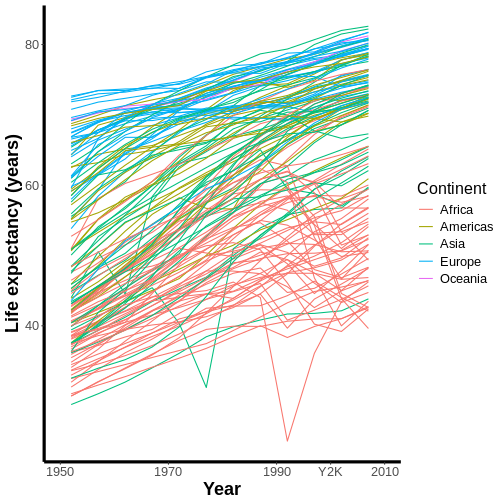
Though there are many other things I would consider adjusting, this is starting to look more polished to me!
Because nearly every ggplot has textual, rectangular, and linear
elements in more or less the same places and serving more or less the
same functions, I recommend crafting a single theme() call
that you save in a separate file and reuse over and over again to style
every ggplot you create. That way, you don’t need to recreate
theme() calls each time (they can get long!), and each of
your graphs will look more similar to each other if you use a similar
design aesthetic each time.
And, if you ever encounter a scenario where your general
theme() is causing problems with a specific aspect
of a specific graph, remember our key concept from earlier:
whenever there’s a conflict for a given aesthetic, the latter rule takes
precedence.
For example, if you normally prefer to not have grid lines,
but you would prefer to have major x-axis grid lines for
this graph, you could apply your general theme first and then
add a second theme() call that contains the specific
adjustment you want to make:
R
ggplot(data = gap,
mapping = aes(x = year, y = lifeExp, group = country)) +
geom_line(mapping = aes(color = continent)) +
scale_x_continuous(name = "Year",
limits = c(1950, 2010),
breaks = c(1950, 1970, 1990, 2000, 2010),
labels = c(1950, 1970, 1990, "Y2K", 2010)) +
scale_y_continuous(name = "Life expectancy (years)") +
scale_color_discrete(name = "Continent") +
theme(panel.grid = element_blank(),
text = element_text(size = 16),
axis.title = element_text(size = 18, face = "bold"),
panel.background = element_rect(fill = "white"),
axis.line = element_line(linewidth = 1.5, color = "black")) +
theme(panel.grid.major.x = element_line(linetype = 'dashed')) #OVERRIDE (PART OF) THE PANEL.GRID AESTHETICS PREVIOUSLY SET.
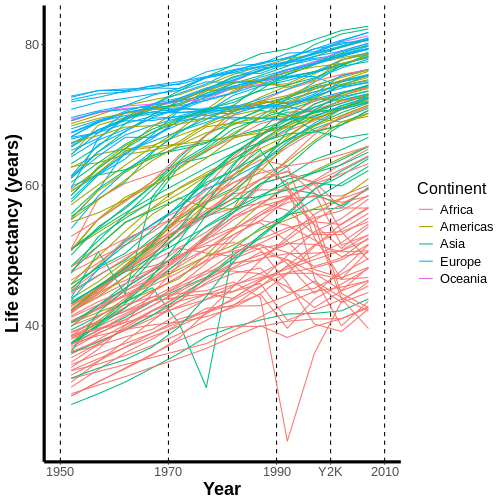
In this case, our second aesthetic command relating to grid lines conflicted with the first and overrode it to the extent necessary.
Faceting and exporting
We’ll cover two more important ggplot2 features in this
lesson. The first is faceting. This is where we take a
grouping variable and, instead of using an aesthetic to differentiate
between groups (e.g., using different colors for different
continents), we instead split our one graph into several sub-panels, one
panel per group.
For example, here’s how we could use the facet_wrap()
function to create five sub-panels of our graph, with each continent now
getting its own panel:
R
ggplot(data = gap,
mapping = aes(x = year, y = lifeExp, group = country)) +
geom_line(mapping = aes(color = continent)) +
scale_x_continuous(name = "Year",
limits = c(1950, 2010),
breaks = c(1950, 1970, 1990, 2000, 2010),
labels = c(1950, 1970, 1990, "Y2K", 2010)) +
scale_y_continuous(name = "Life expectancy (years)") +
scale_color_discrete(name = "Continent") +
theme(panel.grid = element_blank(),
text = element_text(size = 16),
axis.title = element_text(size = 18, face = "bold"),
panel.background = element_rect(fill = "white"),
axis.line = element_line(linewidth = 1.5, color = "black")) +
theme(panel.grid.major.x = element_line(linetype = 'dashed')) +
facet_wrap(facets = ~ continent) #NOTE THE ~ OPERATOR, WHICH MEANS "BY."
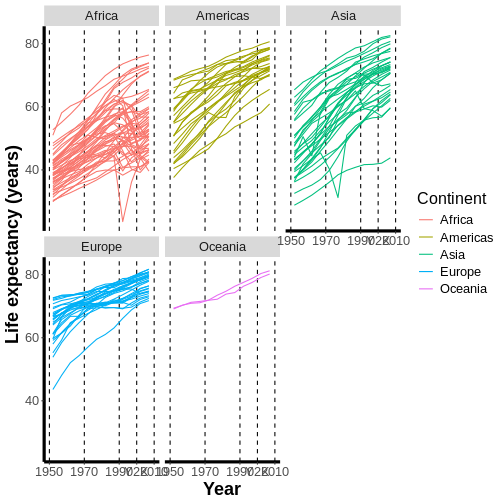
Here, we’ve created five different panels that all share similar aesthetics and characteristics, including a shared legend, uniform axes, and other key similarities. No more assembling multiple sub-panels into one figure manually in PowerPoint (we all know you’ve been doing that)!
If you don’t care for the way the facets get arranged by default, the
related facet_grid() function can be used to arrange them
in a specific way, such as in a 3 rows x 2 columns system instead.
Note the use of the ~ operator in the code above. In
faceting, ~ is used to mean “by,” so, in this case, we are
faceting by continent.
Once you have a really cool graph like this one, you might want to share it. So, your next question is likely to be “how do I save this?”
There are three ways to save a ggplot:
The first is to hit the “Export” button on the Plots panel in the lower-right of your RStudio window. On the screen that appears, you can specify a file name, a format, a size, an aspect ratio, and a destination location, as well as preview the final product. This option is convenient and reproducible, but it’s not programmatic—you’d need to do it manually every time you want to save a new version of your graph rather than writing code to have R do it for you.
The second option is to use R’s built-in image-exporting functions.
For example, if you want to save a specific graph as a .png
file, you could do the following:
R
#CREATE A PLOTTING WINDOW OF THE RIGHT SIZE, AND PRESET A FILE NAME.
png(filename = "plot1.png", width = 400, height = 600, units = "px")
#CALL THE PLOT TO PLACE IT IN THE PLOTTING WINDOW, WHICH'LL ALSO SAVE IT.
plot1
#THEN, TERMINATE THE PLOTTING WINDOW.
dev.off()
This option certainly works, but it’s tedious, and you won’t know if the product will look good until after you’ve save it and opened the new file, so this approach requires some trial and error.
The third option is to use the ggsave() function. This
function works similarly to the approach above in that you can specify a
width and height, but you can also specify a
dpi in case you need your figure to have a certain
resolution. You can also pick a wide range of output file types, which
you specify just through the filename you provide in the
call:
R
ggsave(filename = "results/lifeExp.png", #THE OUTPUT WILL BE A .PNG FILE.
plot = lifeExp_plot, #IF YOU OMIT THIS INPUT, THE LAST PLOT RENDERED WILL BE SAVED.
width = 12,
height = 10,
units = "cm",
dpi = 300)
This lesson was designed to be just a taste of what you can do with
ggplot2. RStudio provides a really useful cheat
sheet of the different layers available, and more extensive
documentation is available on the ggplot2 website. All
RStudio cheat sheets are available from the RStudio
website. Finally, if you have no idea how to change something, a
quick Google search (or ChatGPT query) will usually send you in the
right direction!
Key Points
Every ggplot graph requires a
ggplot()call, a data set, some mapped aesthetics, and one or more geometries. Mixing and matching data and their types, aesthetics, and geometries can result in a near-infinite number of different base graphs.Mapping an aesthetic means linking a visual component of your graph, such as colors or a specific axis, to either a column of data in your data set or to a constant value. To do the former, you must use the
aes()function. To do the latter, you can useaes(), but you don’t need to.Aesthetics can be mapped (and data sets provided) globally within the
ggplot()call, in which case they will apply to all map components, or locally within individualgeom_*()calls, in which case they will apply only to that element.If you want to adjust the appearance of any aesthetic, use the appropriate
scale_*()family function.If you want to adjust the appearance of any text box, line, or rectangle, use the
theme()function, the proper parameter, and the appropriateelement_*()function.In ggplot commands, the
+operator is used to (literally) add additional components or layers to a graph. If multiple layers are added, the layers added later in the command will appear on top of layers specified earlier in the command and may cover them up. If multiple, conflicting specifications are given for a property in the same ggplot command, whichever specification is given later will “win out.”Craft a single
theme()command you can use to provide consistent base styling for every one of your graphs!Use faceting to automatically create a series of sub-panels, one for each member of a grouping variable, that will share the same aesthetics and design properties.
Use the
ggsave()function to programmatically save ggplots as image files with the desired resolution, size, and file type.
Pivoting data frames with the tidyr package
Overview
Questions
- How do scientists produce publication-quality graphs using R?
- What’s it take to build a graph “from scratch,” component by component?
- What’s it mean to “map an aesthetic?”
- Which parts of a ggplot command (both required and optional) control which aspects of plot construction? When I want to modify an aspect of my graphic, how will I narrow down which component is responsible for that aspect?
- How do I save a finished graph?
- What are some ways to put my unique “stamp” on a graph?
Objectives
Distinguish between “long” and “wide” formats for storing the same data in a rectangular form.
Convert a data frame between ‘longer’ and ‘wider’ formats using the
pivot_*()functions intidyr.Appreciate that “longness” and “wideness” are a continuum and that data frames can be “long” in some respects and “wide” in others.
Anticipate the most seamless data storage format to use within your own workflows.
Overview
Questions
- Wait, there are different ways to store the same data in a rectangular form? What are they? What are their advantages and disadvantages?
- What do we really mean when we say that our data are “long” or “wide?”
- How do I make my data structure “longer” or “wider?”
Objectives
Distinguish between “long” and “wide” formats for storing the same data in a rectangular form.
Convert a data frame between ‘longer’ and ‘wider’ formats using the
pivot_*()functions intidyr.Appreciate that “longness” and “wideness” are a continuum and that data frames can be “long” in some respects and “wide” in others.
Anticipate the most seamless data storage format to use within your own workflows.
Introduction
Callout
Important: There is no one “right” way to store data in a table! There are many advantages and disadvantages to each way and, in some ways, so long as your organizational system follows good data science storage conventions, is consistent, and works for you and your team, then you’re storing your data “right.”
That said, from a computing standpoint, there are two broad ways to think about how the same data can be stored in a table: in “wide” format or in “long” format.
Imagine you had stats from several basketball teams, include the numbers of points, assists, and rebounds each team earned in their most recent game. You could store the exact same data in two very different ways:

In “wide” format, each row is usually a grouping, site, or individual for which multiple observations were recorded, and each column is everything you know about that entity, perhaps at several different times.
In “long” format, each row is a single observation (even if you have several observations per group/site/individual), and the columns serve to clarify which entity or entities each observation belongs to.
Regardless, the exact same information is being stored—it’s just arranged and conveyed differently!
Note that, when I say “long” and “wide,” I don’t mean in the physical sense related to how much data you’re storing. Obviously, if you have a lot of data, you’re going to have a lot of rows and/or columns, so your data set could look “long” even though it’s actually organized in a “wide” format and vice versa.
Discussion
Important: One consequence of data organization is that it influences how easy (or difficult!) it’ll be to use a programming language like R to manipulate your data.
Consider: How would you use dplyr’s
mutate() function to calculate a “points per rebound” value
for each team using the “wide” format data set shown above? How about
for the “long” format data set?
Then, consider: How would you use dplyr’s
summarize() function to get an average number of assists
across all teams using the “wide” format data set shown above? How about
the “long” format data set?
With the data in “wide” format, using mutate() to
calculate “points per rebound” for each team would be easy because the
two values for each team (Points and Rebounds)
are in the same row. So, we’d do something like this:
R
dataset %>%
mutate(pts_per_rebound = Points/Rebounds)
However, with the data in “long” format, it’s not at all
obvious how (or even if) one could use mutate() to get what
we want. The numbers we’re trying to slam together are in different rows
in this format, and mutate is a “row-focused” tool—it’s designed for
leveraging data being stored more “widely.”
Similarly, with the data in “wide” format, using
summarize() to calculate an average number of
Assists across all teams would be easy because all the
numbers we’re trying to smash together are in the same column.
So, we’d do something like this:
R
dataset %>%
summarize(mean_assists = mean(Assists))
Callout
Yes, you can use summarize() without using
group_by() if you don’t want to create a summary separately
for each member of a group (or if you have no groups to group by!).
However, once again, the “long” format version presents difficulties.
There are numbers in the Value column we’d need to avoid
here to calculate our average. So, it’d require us to use
filter() first to remove these:
R
dataset %>%
filter(Variable == Assists) %>% #Notice I have to filter by the Variable column...
summarize(mean_assists = mean(Value)) #...But take the mean of the Value column.
So, summarize() seems like a tool also designed
for “wide” format data, but that’s only because our wide-format
data have already been grouped by team. In fact,
group_by() and summarize() are best thought of
as tools designed to work best with “long” format data because we need
to be able to easily sub-divide our data into groups to then be able to
summarize them effectively, and long formats tend to have more “grouping
variables” to help us do that.
This whole exercise is designed to show you that while, to some extent, data organization is “personal preference,” it also has implications for how we manipulate our data (and how easy or hard it will be to do so).
While this is perhaps over-generalizing, I would say that humans tend to prefer reading and recording data in “wider” formats. When we report data in tables or record data on data sheets, we tend to do so across rows rather than down columns. Recording data in long format, in particular, tends to feel tedious because it requires us to fill out “grouping variable” data many times with much of the same information.
However, computers tend to “prefer” data stored in “longer”
formats (regardless of what the previous example may have led
you to believe!). Computers don’t “see” natural groupings in data like
humans can, so they count on having columns that clarify these groups
(like continent and country do in the
gapminder dataset), and those types of columns only exist
in “longer” formats. In particular, many dplyr verbs prefer
your data are in “long” format (mutate() is one exception),
and ggplot2 especially expects to receive data in
“long” format if you want to be able to map any
grouping aesthetics.
This may seem like a dilemma—we’re torn between how we’d
prefer the data to look and how R would prefer them to look.
But, remember, it’s all the same data, just arranged differently. So, it
seems like there should be a way to “reshape” our data to suit both
needs. And there is: The tidyr package’s functions
pivot_longer() and pivot_wider().
Minding the Gapminder
Discussion
Let’s take another good look at the gapminder data set
to remind ourselves of its structure:
R
head(gap)
OUTPUT
country continent year lifeExp pop gdpPercap
1 Afghanistan Asia 1952 28.801 8425333 779.4453
2 Afghanistan Asia 1957 30.332 9240934 820.8530
3 Afghanistan Asia 1962 31.997 10267083 853.1007
4 Afghanistan Asia 1967 34.020 11537966 836.1971
5 Afghanistan Asia 1972 36.088 13079460 739.9811
6 Afghanistan Asia 1977 38.438 14880372 786.1134Consider: Is the gapminder data set in “long” format or
“wide” format? Why do you say that?
Sorry, but this is sort of a trick question because the right answer is “both” (or “neither”).
On the one hand, the gapminder data set is not
as “long” as it could be. For example, right now,
there are three columns containing numeric data (pop,
lifeExp, and gdpPercap). We could
instead have a single Value column to hold all these data,
as we had with our fake sports data earlier, and a second column that
lists what kind of Value each row contains.
On the other hand, the gapminder data set is also not
as “wide” as it could be either. For example, right
now, there are three grouping variables (country,
year, and continent). We could
instead have a single row per country and then separate
columns for the data from each year (i.e.,
pop1952, pop1957, pop1962,
etc.) for each country.
Callout
So, “longness” vs. “wideness” is a spectrum, and the
gapminder data set exists sort of in the middle!
Hold onto this idea—for the rest of this lesson, we’re going to see how to make those longer and wider versions we just imagined!
PIVOT_LONGER
We’ll begin by seeing how to make our data even longer than it is now
by combining all the values in the pop,
lifeExp, and gdpPercap columns into a single
column called Value. We’ll then add a second column
(officially called a key column), a grouping column,
that clarifies which Statistic is being stored in
the Value column in that row.
The tidyr verb that corresponds with this desire is
pivot_longer(). As with most tidyverse verbs,
the first input to pivot_longer() is
always the data frame you are trying to reshape (or
pivot). In this case, that will be our
gapminder data set.
After providing our data set, we will provide three more inputs in this particular case:
The columns we are eliminating and collapsing into a single column. Here, that will be the
pop,lifeExp, andgdpPercapcolumns. We’ll provide these as inputs to thecolsparameter, specifically.The name of the new column that will hold all the values that used to be held by the columns we’re eliminating. We’ll call this new column
Value, and we’ll provide that name as the input to thevalues_toparameter.The name of the new key column that clarifies which statistic is being stored in the
Valuecolumn in a given row. We’ll call this new columnStatistic, and we’ll provide this name as the input to thenames_toparameter.
Let’s put all this together and see what it looks like!
R
gap_longer = gap %>%
pivot_longer(cols = c(pop, lifeExp, gdpPercap),
values_to = "Value",
names_to = "Statistic")
head(gap_longer)
OUTPUT
# A tibble: 6 × 5
country continent year Statistic Value
<fct> <fct> <int> <chr> <dbl>
1 Afghanistan Asia 1952 pop 8425333
2 Afghanistan Asia 1952 lifeExp 28.8
3 Afghanistan Asia 1952 gdpPercap 779.
4 Afghanistan Asia 1957 pop 9240934
5 Afghanistan Asia 1957 lifeExp 30.3
6 Afghanistan Asia 1957 gdpPercap 821. The first thing I want you to notice about our new
gap_longer object (by looking in the
‘Environment Pane’) it is indeed much longer than gap was;
it’s now up to 5112 rows! It also has one fewer column.
Challenge
The other important thing to notice is the contents of the new
Statistic column. Where did this column’s contents come
from?
It’s now storing the names of the old columns, the ones we got rid of! It figures if those names were good enough to serve as column names in the original data, they must be good enough to be grouping data in this new structure too!
PIVOT_WIDER
Now, we’ll go the other way—we’ll make our gapminder
data set wider than it already is. We’ll make a data set that has a
single row for each country (countries will be our groups)
and we’ll have a different column for every year x
“Statistic” combo we have for each country.
The tidyr verb that corresponds with this desire is
pivot_wider(), and it works very similarly to
pivot_longer(). Besides our data frame (first input), we’ll
provide pivot_wider() two inputs:
- The column(s) we’re going to eliminate by spreading their
contents out over several new columns. In our new, wider data set,
we’re going to have a column for each
yearx “Statistic” combination, so we’re going to eliminate the currentpop,lifeExp, andgdpPercapcolumns as we know them. We’ll provide these columns as inputs topivot_wider()’svalues_fromparameter, as in “take the values for these new columns from those in these old columns.” - The column that we’re going to eliminate by instead inserting it
into the names of the new columns we’re creating. Here, that’s going
to be the
yearcolumn (I promise this’ll make more sense when you see it!). We’ll provide this as an input to thenames_fromparameter, as in “take the names of the new columns from this old column’s name.”
Let’s see what this looks like:
R
gap_wider = gap %>%
pivot_wider(values_from = c(pop, lifeExp, gdpPercap),
names_from = year)
head(gap_wider)
OUTPUT
# A tibble: 6 × 38
country continent pop_1952 pop_1957 pop_1962 pop_1967 pop_1972 pop_1977
<fct> <fct> <int> <int> <int> <int> <int> <int>
1 Afghanistan Asia 8425333 9240934 10267083 11537966 13079460 14880372
2 Albania Europe 1282697 1476505 1728137 1984060 2263554 2509048
3 Algeria Africa 9279525 10270856 11000948 12760499 14760787 17152804
4 Angola Africa 4232095 4561361 4826015 5247469 5894858 6162675
5 Argentina Americas 17876956 19610538 21283783 22934225 24779799 26983828
6 Australia Oceania 8691212 9712569 10794968 11872264 13177000 14074100
# ℹ 30 more variables: pop_1982 <int>, pop_1987 <int>, pop_1992 <int>,
# pop_1997 <int>, pop_2002 <int>, pop_2007 <int>, lifeExp_1952 <dbl>,
# lifeExp_1957 <dbl>, lifeExp_1962 <dbl>, lifeExp_1967 <dbl>,
# lifeExp_1972 <dbl>, lifeExp_1977 <dbl>, lifeExp_1982 <dbl>,
# lifeExp_1987 <dbl>, lifeExp_1992 <dbl>, lifeExp_1997 <dbl>,
# lifeExp_2002 <dbl>, lifeExp_2007 <dbl>, gdpPercap_1952 <dbl>,
# gdpPercap_1957 <dbl>, gdpPercap_1962 <dbl>, gdpPercap_1967 <dbl>, …As the name suggests, gap_wider is indeed much wider
than our original gapminder data set: It has
38 columns instead of the original 6. We also
have fewer rows: Just 142 (one per country)
compared to the original 1704.
Importantly, our new columns have intuitive, predictable names:
gdpPercap_1972, pop_1992, and
lifeExp1987, etc. Hopefully this is making more
sense to you now!
Challenge
You’ve now seen both pivot_longer() and
pivot_wider(). Maybe you’ve noticed they seem like
“opposites?” They are! They’re designed to “undo” the other’s
work, in fact!
So, use pivot_wider() to “rewind”
gap_longer back to the organization of our original data
set.
This task is thankfully relatively easy. We tell R that it
should pull the names for the new columns in our wider table from the
Statistic column, then pull the values for those new
columns from the old Value column:
R
gap_returned1 = gap_longer %>%
pivot_wider(names_from = Statistic,
values_from = Value)
head(gap_returned1)
OUTPUT
# A tibble: 6 × 6
country continent year pop lifeExp gdpPercap
<fct> <fct> <int> <dbl> <dbl> <dbl>
1 Afghanistan Asia 1952 8425333 28.8 779.
2 Afghanistan Asia 1957 9240934 30.3 821.
3 Afghanistan Asia 1962 10267083 32.0 853.
4 Afghanistan Asia 1967 11537966 34.0 836.
5 Afghanistan Asia 1972 13079460 36.1 740.
6 Afghanistan Asia 1977 14880372 38.4 786.Challenge
Now, use pivot_longer() to “rewind”
gap_wider back to the organization of the original data
set. This transformation is a little more complicated; you’ll
need to specify slightly different inputs than the ones you’ve seen
before:
- For the
names_toparameter, specify exactlyc(".value", "year").".value"is a special input value here that has a particular meaning—see if you can guess what that is! Hint: You can use?pivot_longer()to research the answer, if you’d like. - You’ll also need to specify exactly
"_"as an input for thenames_sepparameter. See if you can guess why. - Lastly, you won’t need to specify anything for the
values_toparameter this time—".value"is taking care of the need to put anything there.
Here’s how we’d use pivot_longer() to “rewind” to our
original data set:
R
gap_returned2 = gap_wider %>%
pivot_longer(cols = pop_1952:gdpPercap_2007,
names_to = c(".value", "year"),
names_sep = "_")
head(gap_returned2)
OUTPUT
# A tibble: 6 × 6
country continent year pop lifeExp gdpPercap
<fct> <fct> <chr> <int> <dbl> <dbl>
1 Afghanistan Asia 1952 8425333 28.8 779.
2 Afghanistan Asia 1957 9240934 30.3 821.
3 Afghanistan Asia 1962 10267083 32.0 853.
4 Afghanistan Asia 1967 11537966 34.0 836.
5 Afghanistan Asia 1972 13079460 36.1 740.
6 Afghanistan Asia 1977 14880372 38.4 786.Our inputs for names_to were telling R “the names of the
new columns should come from the first parts of the names of
the columns we’re getting rid of.” That’s what the
".values" bit is doing!
Then, we were telling R “the other column you should make should
simply be called year.”
Lastly, by saying names_sep = "_", we were indicating
that R should hack apart the old column names at the underscores (aka
separate the old names at the _) to find the
proper bits to use in the new column names.
So, R pulled apart the old column names, creating pop,
lifeExp, and gdpPercap columns from their
front halves, and then putting the remaining years in the old column
names into the new year column. Pretty incredible,
huh??
Try to rephrase the above explanation in your own words!
Bonus: separate_*() and unite()
One of the reasons tidyr is such a useful package is
that it introduces easy pivoting to R, an operation
many researchers instead use non-coding-based programs like Microsoft
Excel to perform. While we’re on the subject of tidyr, we
thought we’d mention two other tidyr functions that can do
things you might otherwise do in Excel.
The first of these functions is unite(). It’s common to
want to take multiple columns and glue their contents together into a
single column’s worth of values (in Excel, this is called
concatenation).
For example, maybe you’d rather have a column of country names with
the relevant continent tacked on via underscores (e.g.,
"Albania_Europe").
You could produce such a column already using dplyr’s
mutate() function combined with R’s paste0()
function, which pastes together a mixture of values and text into a
single text value:
R
gap %>%
mutate(new_col = paste0(country,
"_",
continent)) %>%
select(new_col) %>%
head()
OUTPUT
new_col
1 Afghanistan_Asia
2 Afghanistan_Asia
3 Afghanistan_Asia
4 Afghanistan_Asia
5 Afghanistan_Asia
6 Afghanistan_AsiaHowever, this is approach is a little clunky.
unite() can do this same operation more cleanly and
clearly:
R
gap %>%
unite(col = "new_col", #NAME NEW COLUMN
c(country, continent), #COLUMNS TO COMBINE
sep = "_") %>% #HOW TO SEPARATE THE ORIGINAL VALUES, IF AT ALL.
select(new_col) %>%
head()
OUTPUT
new_col
1 Afghanistan_Asia
2 Afghanistan_Asia
3 Afghanistan_Asia
4 Afghanistan_Asia
5 Afghanistan_Asia
6 Afghanistan_AsiaJust as often, we want to break a single column’s contents apart
across multiple new columns. For example, maybe we want to split our
four-digit year data in two columns: one for the first two digits and
one for the last two (e.g., 1975 becomes
19 and 75).
In Excel, you might use the “Text to Columns” functionality to split a column apart like this, either at a certain number of characters or at a certain delimiter, such as a space, a comma, or an underscore.
In tidyr, we can use the separate_*()
family of functions to do this. separate_wider_delim() will
break one column into two (or more) based on a specific delimiter,
whereas separate_wider_position() will break one column
into two (or more) based on a number of characters, which is what we
want to do here:
R
gap %>%
separate_wider_position(cols = year, #COLUMN(S) TO SPLIT
widths = c("decades" = 2, "years" = 2)) %>% #NEW COLUMNS: "NAMES" = NUMBER OF CHARACTERS
select(decades, years) %>%
head()
OUTPUT
# A tibble: 6 × 2
decades years
<chr> <chr>
1 19 52
2 19 57
3 19 62
4 19 67
5 19 72
6 19 77 Performing operations like these in R instead of in Excel makes them more reproducible!
Key Points
- Use the
tidyrpackage to reshape the organization of your data. - Use
pivot_longer()to go towards a “longer” layout. - Use
pivot_wider()to go towards a “wider” layout. - Recognize that “longness” and “wideness” is a continuum and that your data may not be as “long” or as “wide” as they could be.
- Recognize that there are advantages and disadvantages to every data layout.
